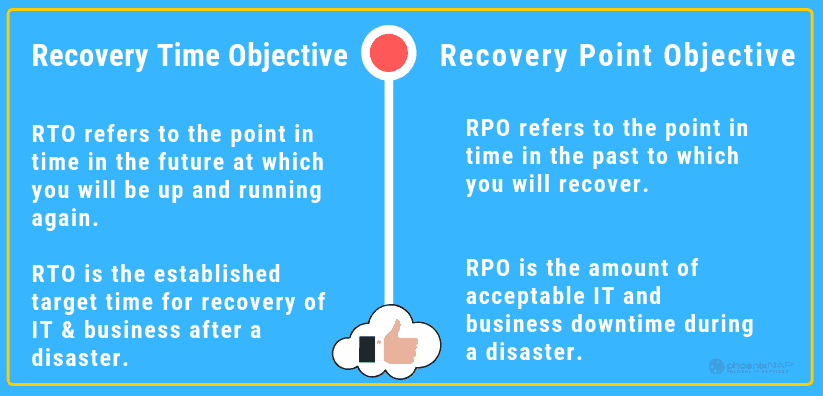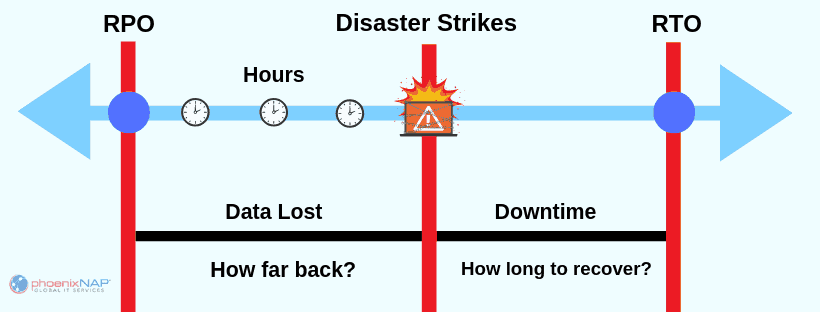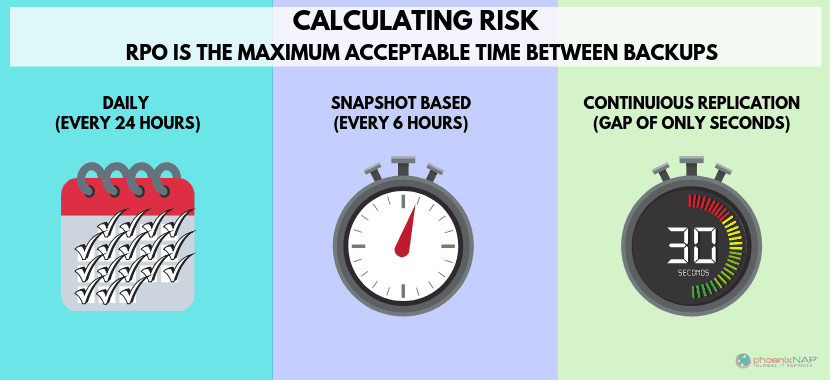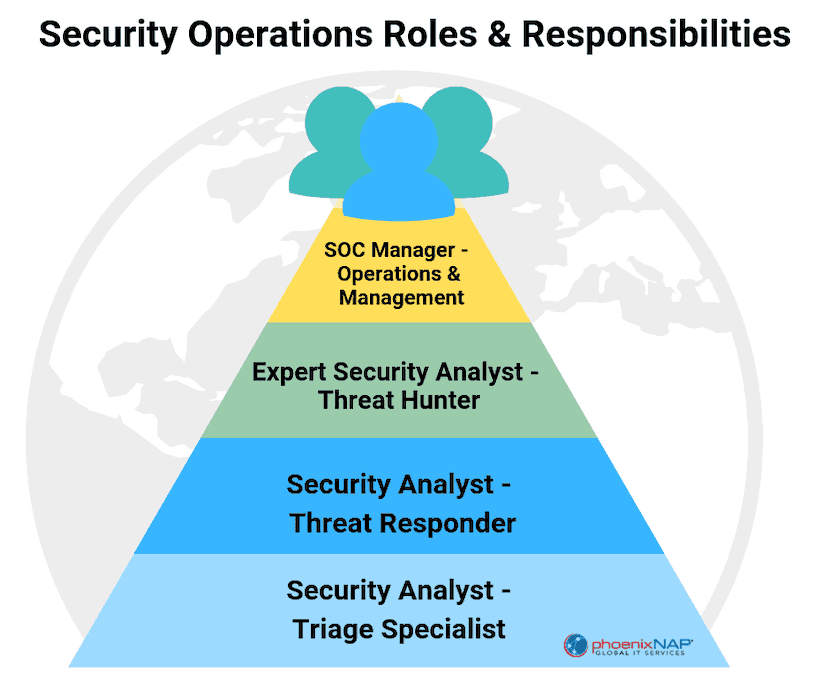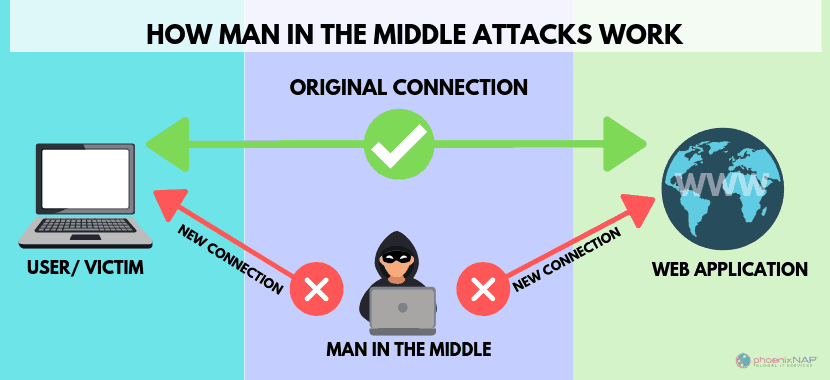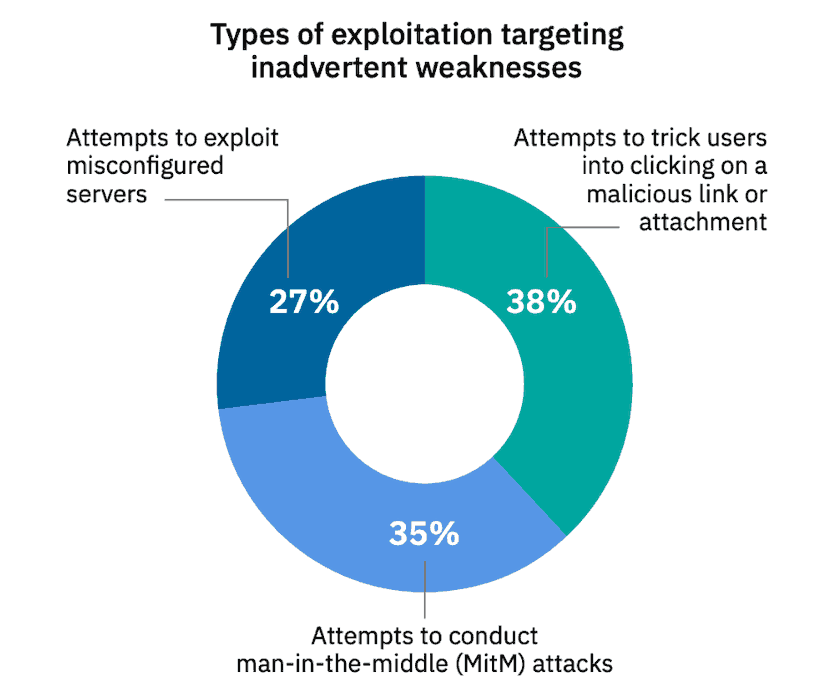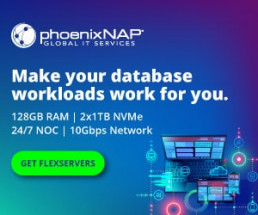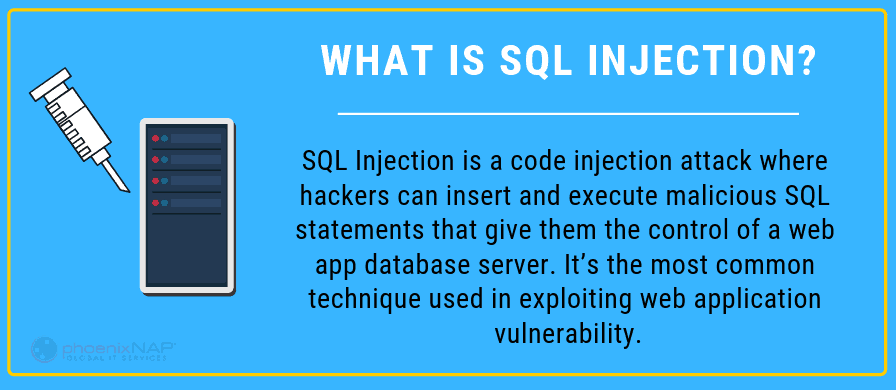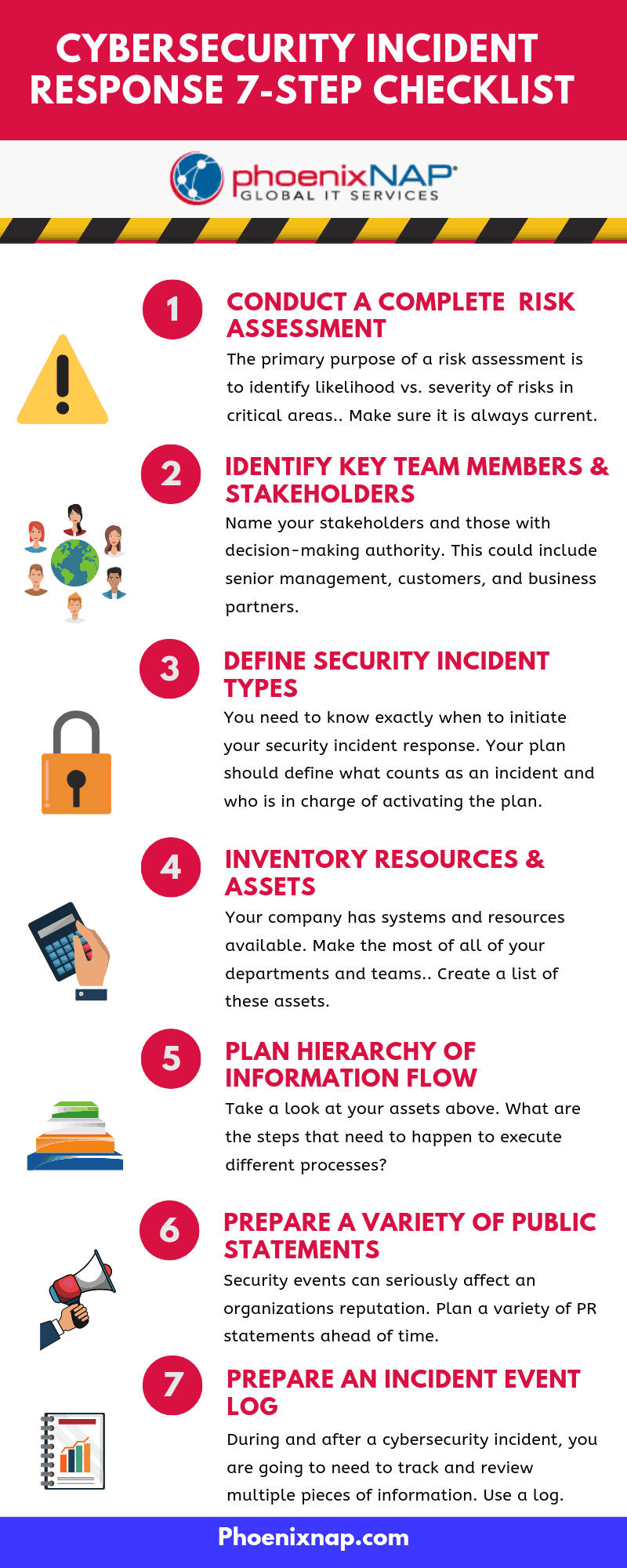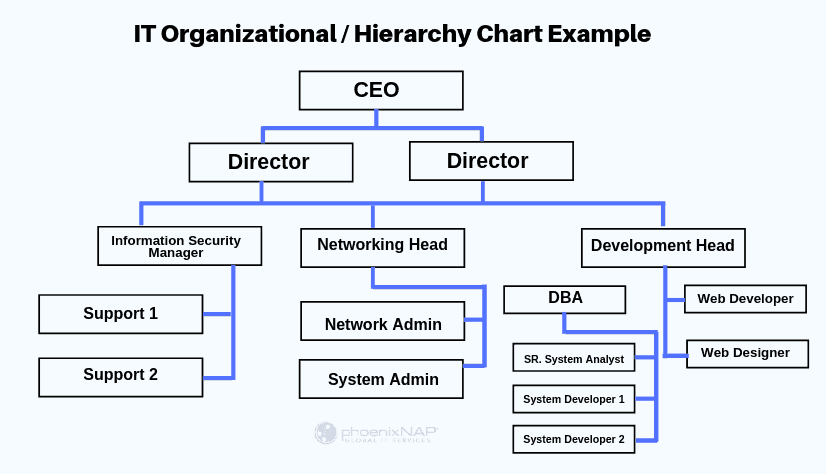RTO (Recovery Time Objective) vs RPO (Recovery Point Objective)
In this article you will learn:
- What Recovery Time Objective (RTO) and Recovery Point Objective (RPO) are. Why they are critical to your data recovery and protection strategy.
- Intelligent data management starts with a plan to avoid catastrophic losses — disaster recovery planning can guarantee the survival of your business when an emergency strikes.
- How business continuity planning minimizes the loss of revenue while also boosting customer confidence.
Recovery Time Objective and Recovery Point Objective may sound alike, but they are entirely different metrics in disaster recovery and business continuity management.
Find out how to plan accordingly with the proper resources before you need them. Much like having insurance, you may never use it – or it may save your company.
In this article, we will examine the critical differences between RPO and RTO and clear up any confusion!
RTO: Recovery Time Objective
RTO dictates how quickly your infrastructure needs to be back online after a disaster. Sometimes, we use RTO to define the maximum downtime a company can handle and maintain business continuity. This is often a target time set for services restoration after a disaster. For example, a Recovery Time Objective of 2 hours aims to have everything back up and running within two hours of service disruption notification.
Sometimes, such RTO is not achievable. A hurricane or a flood can bring down a business, leaving it down for weeks. However, some organizations are more resilient to outages.
For example, a small plumbing company could get by with paperwork orders and invoicing for a week or more. A business with a web-based application that relies on subscriptions might be crippled after only a few hours.
In the case of outsourced IT services, RTO is defined within a Service Level Agreement (SLA). IT and other service providers typically include the following support terms in their SLA:
- Availability: the hours you can call for support.
- Response time: how quickly they contact you after a support request.
- Resolution time: how quickly they will restore the services.
Depending on your business requirements, you may need better RTO. With it, the costs increase as well. Whatever RTO you choose, it should be cost-effective for your organization.
Businesses can handle RTO internally. If you have an in-house IT department, there should be a goal for resolving technical problems. The ability to fulfill the RTO depends on the severity of the disaster. An objective of one hour is attainable for a server crash. However, it might not be realistic to expect a one-hour solution in case of a natural disaster in the area.
RTO includes more than just the amount of time to needed to recover from a disaster. It should also include steps to mitigate or recover from different disasters. The plan needs to contain proper testing for the measures
RPO: Recovery Point Objective
An RPO measures the acceptable amount of data loss after a disruption of service.
For example, lost sales may become an excessive burden against costs after 18 hours. That threshold may put a company below any sales targets.
Backups and mirror-copies of data are an essential part of RPO solutions. It is necessary to know how much data is an acceptable loss. Some businesses address this by calculating storage costs versus recovery costs. This helps determine how often to create backups. Other businesses use cloud storage to create a real-time clone of their data. In this scenario, a failover happens in a matter of seconds.
Similar to RTO and acceptable downtime, some businesses have better loss tolerance for data. Retrieving 18 hours of records for a small plumbing company is possible but may not be detrimental to the business operation. In contrast, an online billing company may find itself in trouble after only a few minutes worth of data loss.
RPO is categorized by time and technology:
- 8-24 hours: These objectives rely on external storage data backups of the production environment. The last available backup serves as a restoration point.
- Up to 4 hours: These objectives require ongoing snapshots of the production environment. In a disaster, getting data back is faster and brings less disruption to your business.
- Near zero: These objectives use enterprise cloud backup and storage solutions to mirror or replicate data. Frequently, these services replicate data in multiple geographic locations for maximum redundancy. The failover and failback are seamless.
Both RTO and RPO involve periods of time for the measurements. However, while RTO focuses on bringing hardware and software online, RPO focuses on acceptable data loss.
Calculation of Risk
Both RTO and RPO are calculations of risk. RTO is a calculation of how long a business can sustain a service interruption. RPO is a calculation of how recent the data will be when it is recovered.
Calculating RTO
We base RTO calculation on projection and risk management. A frequently used application may be critical for business continuity in the same way a seldom-used application is. Hence, the importance of an application does not have to be the same as the frequency of usage. You need to decide which services can be unavailable for how long and if they are critical to your business.
To calculate RTO, consider these factors:
- The cost per hour of outage
- The importance and priority of individual systems
- Steps required to mitigate or recover from a disaster (including individual components or processes)
- Cost/benefit equation for recovery solutions
Calculating RPO
Calculating an RPO is also based on risk. In a disaster, a degree of data loss may be imminent. RPO becomes a balancing act between the impact of data loss on the business and the cost of mitigation. A few angry customers, because their orders are lost, might be an acceptable loss. In contrast, hundreds of lost transactions might be a massive blow to a business.
Consider these factors when determining your RPO:
- The maximum tolerable amount of data loss that your organization can sustain.
- The cost of lost data and operations
- The cost of implementing recovery solutions
RPO is the maximum acceptable time between backups. If data backups are performed every 6 hours, and a disaster strikes 1 hour after the backup, you will lose only one hour of data. This means you are 5 hours under the projected RPO.
Disaster Recovery Planning
Disasters come in many forms. Such as a natural disaster, hurricane, flood, or a wildfire. A disaster could also refer to a catastrophic failure of assets or infrastructure, like power lines, bridges, or servers.
Disasters include all types of cybersecurity attacks that destroy your data, compromise credit card information, or even disable an entire site.
With so many definitions of disaster, it is helpful to define them in terms of what they have in common. For organizations and IT departments, a disaster is an event that disrupts normal business operation.
Dealing with disasters starts with planning and prevention. Many businesses use cloud solutions in different geographical regions to minimize the risk of downtime. Some install redundant hardware to keep the IT infrastructure running.
A crucial step in data recovery is to develop a Disaster Recovery plan.
Consider the probability of different kinds of disasters. Various disasters may warrant different response plans. For example, in the Pacific Northwest, hurricanes are rare, but earthquakes can occur. In Florida, the reverse is true. Cyber-attacks may be more of a threat to larger businesses with extensive online presence than smaller ones. A DDoS attack might warrant a different response than a data breach.
A Disaster Recovery Plan helps to bring systems and processes online much faster than ad hoc solutions. When everyone plays a specific role, a recovery strategy can proceed quickly. A DR plan also helps put resources in place before you need them. Therefore, response plans improve Recovery Time and Recovery Point Objectives.
Difference Between RTO and RPO is Critical
While closely related, it is essential to understand the differences between Recovery Time Objective and Recovery Point Objective
RTO refers to the amount of time you need to bring a system back online. RPO is a business calculation for acceptable data loss from downtime.
Improve these metrics and employ a Disaster Recovery plan today.
Recent Posts
What is a Security Operations Center (SOC)? Best Practices, Benefits, & Framework
In this article you will learn:
- Understand what a Security Operations Center is and active how detection and response prevent data breaches.
- Six pillars of modern security operations you can’t afford to overlook.
- The eight forward-thinking SOC best practices to keep an eye on the future of cybersecurity. Including an overview and comparison of current Framework Models.
- Discover why your organization needs to implement a security program based on advanced threat intelligence.
- In-house or outsource to a managed security provider? We help you decide.
The average total cost of a data breach in 2018 was $3.86 million. As businesses grow increasingly reliant on technology, cybersecurity is becoming a more critical concern.
Cloud security can be a challenge, particularly for small to medium-sized businesses that don’t have a dedicated security team on-staff. The good news is that there is a viable option available for companies looking for a better way to manage security risks – security operations centers (SOCs).
In this article, we’ll take a closer look at what SOCs are, the benefits that they offer. We will also take a look at how businesses of all sizes can take advantage of SOCs for data protection.
What is a Security Operations Center?
A security operations center is a team of cybersecurity professionals dedicated to preventing data breaches and other cybersecurity threats. The goal of a SOC is to monitor, detect, investigate, and respond to all types of cyber threats around the clock.
Team members make use of a wide range of technological solutions and processes. These include security information and event management systems (SIEM), firewalls, breach detection, intrusion detection, and probes. SOCs have many tools to continuously perform vulnerability scans of a network for threats and weaknesses and address those threats and deficiencies before they turn into a severe issue.
It may help to think of a SOC as an IT department that is focused solely on security as opposed to network maintenance and other IT tasks.
6 Pillars of Modern SOC Operations
Companies can choose to build a security operations center in-house or outsource to an MSSP or managed security service providers that offer SOC services. For small to medium-sized businesses that lack resources to develop their own detection and response team, outsourcing to a SOC service provider is often the most cost-effective option.
Through the six pillars of security operations, you can develop a comprehensive approach to cybersecurity.
-
-
Establishing Asset Awareness
The first objective is asset discovery. The tools, technologies, hardware, and software that make up these assets may differ from company to company, and it is vital for the team to develop a thorough awareness of the assets that they have available for identifying and preventing security issues.
-
Preventive Security Monitoring
When it comes to cybersecurity, prevention is always going to be more effective than reaction. Rather than responding to threats as they happen, a SOC will work to monitor a network around-the-clock. By doing so, they can detect malicious activities and prevent them before they can cause any severe damage.
-
Keeping Records of Activity and Communications
In the event of a security incident, soc analysts need to be able to retrace activity and communications on a network to find out what went wrong. To do this, the team is tasked detailed log management of all the activity and communications that take place on a network.
-
-
Ranking Security Alerts
When security incidents do occur, the incident response team works to triage the severity. This enables a SOC to prioritize their focus on preventing and responding to security alerts that are especially serious or dangerous to the business.
-
Modifying Defenses
Effective cybersecurity is a process of continuous improvement. To keep up with the ever-changing landscape of cyber threats, a security operations center works to continually adapt and modify a network’s defenses on an ongoing, as-needed basis.
-
Maintaining Compliance
In 2019, there are more compliance regulations and mandatory protective measures regarding cybersecurity than ever before. In addition to threat management, a security operations center also must protect the business from legal trouble. This is done by ensuring that they are always compliant with the latest security regulations.
Security Operations Center Best Practices
As you go about building a SOC for your organization, it is essential to keep an eye on what the future of cybersecurity holds in store. Doing so allows you to develop practices that will secure the future.
SOC Best Practices Include:
Widening the Focus of Information Security
Cloud computing has given rise to a wide range of new cloud-based processes. It has also dramatically expanded the virtual infrastructure of most organizations. At the same time, other technological advancements such as the internet of things have become more prevalent. This means that organizations are more connected to the cloud than ever before. However, it also means that they are more exposed to threats than ever before. As you go about building a SOC, it is crucial to widen the scope of cybersecurity to continually secure new processes and technologies as they come into use.
Expanding Data Intake
When it comes to cybersecurity, collecting data can often prove incredibly valuable. Gathering data on security incidents enables a security operations center to put those incidents into the proper context. It also allows them to identify the source of the problem better. Moving forward, an increased focus on collecting more data and organizing it in a meaningful way will be critical for SOCs.
Improved Data Analysis
Collecting more data is only valuable if you can thoroughly analyze it and draw conclusions from it. Therefore, an essential SOC best practice to implement is a more in-depth and more comprehensive analysis of the data that you have available. Focusing on better data security analysis will empower your SOC team to make more informed decisions regarding the security of your network.
Take Advantage of Security Automation
Cybersecurity is becoming increasingly automated. Taking DevSecOps best practices to complete more tedious and time-consuming security tasks free up your team to focus all of their time and energy on other, more critical tasks. As cybersecurity automation continues to advance, organizations need to focus on building SOCs that are designed to take advantage of the benefits that automation offers.
Security Operations Center Roles and Responsibilities
A security operations center is made up of a number of individual team members. Each team member has unique duties. The specific team members that comprise the incident response team may vary. Common positions – along with their roles and responsibilities – that you will find in a security team include:
-
SOC Manager
The manager is the head of the team. They are responsible for managing the team, setting budgets and agendas, and reporting to executive managers within the organization.
-
Security Analyst
A security analyst is responsible for organizing and interpreting security data from SOC report or audit. Also, providing real-time risk management, vulnerability assessment, and security intelligence provide insights into the state of the organization’s preparedness.
-
Forensic Investigator
In the event of an incident, the forensic investigator is responsible for analyzing the incident to collect data, evidence, and behavior analytics.
-
Incident Responder
Incident responders are the first to be notified when security alerts happen. They are then responsible for performing an initial evaluation and threat assessment of the alert.
-
Compliance Auditor
The compliance auditor is responsible for ensuring that all processes carried out by the team are done so in a way that complies with regulatory standards.
SOC Organizational Models
Not all SOCs are structured under the same organizational model. Security operations center processes and procedures vary based on many factors, including your unique security needs.
Organizational models of security operations centers include:
- Internal SOC
An internal SOC is an in-house team comprised of security and IT professionals who work within the organization. Internal team members can be spread throughout other departments. They can also comprise their own department dedicated to security. - Internal Virtual SOC
An internal virtual SOC is comprised of part-time security professionals who work remotely. Team members are primarily responsible for reacting to security threats when they receive an alert. - Co-Managed SOC
A co-managed SOC is a team of security professionals who work alongside a third-party cybersecurity service provider. This organizational model essentially combines a semi-dedicated in-house team with a third-party SOC service provider for a co-managed approach to cybersecurity. - Command SOC
Command SOCs are responsible for overseeing and coordinating other SOCs within the organization. They are typically only found in organizations large enough to have multiple in-house SOCs. - Fusion SOC
A fusion SOC is designed to oversee the efforts of the organization’s larger IT team. Their objective is to guide and assist the IT team on matters of security. - Outsourced Virtual SOC
An outsourced virtual SOC is made up of team members that work remotely. Rather than working directly for the organization, though, an outsourced virtual SOC is a third-party service. Outsourced virtual SOCs provide security services to organizations that do not have an in-house security operations center team on-staff.
Take Advantage of the Benefits Offered by a SOC
Faced with ever-changing security threats, the security offered by a security operations center is one of the most beneficial avenues that organizations have available. Having a team of dedicated information security professionals monitoring your network, security threat detection, and working to bolster your defenses can go a long way toward keeping your sensitive data secure.
If you would like to learn more about the benefits offered by a security operations center team and the options that are available for your organization, we invite you to contact us today.
Recent Posts
What are Man in the Middle Attacks & How to Prevent MITM Attack With Examples
In this article you will learn:
- Learn what a MITM Attack is & How they work including real-life examples.
- Find out how hackers use Man-in-the-middle attacks, to interject between you and financial institutions, corporate email communication, private internal messaging, and more.
- Prevention tactics and best practices to implement immediately.
- Discover how to identify a man in the middle attack before a data breach impacts your organization.
What is a Man in the Middle Attack? How Does it Work?
A Man-in-the-Middle (MITM) attack happens when a hacker inserts themselves between a user and a website. This kind of attack comes in several forms. For example, a fake banking website may be used to capture financial login information. The fake site is “in the middle” between the user and the actual bank website.
Attackers have many different reasons and methods for using a MITM attack. Typically, they’re trying to steal something, like credit card numbers or user login credentials. Sometimes they’re snooping on private conversations, which might include trade secrets or other valuable information.
One thing that almost all attacks have in common is the bad guy is pretending to be someone (or a website) you trust.
Types of Man-in-the Middle Attacks
Wi-Fi Eavesdropping
If you’ve ever used a laptop in a coffee shop, you may have noticed a pop-up that says “This network is not secure.” Public wi-fi is usually provided “as-is,” with no guarantees over the quality of service.
However, unencrypted wi-fi connections are easy to eavesdrop. It’s much like having a conversation in a public restaurant – anyone can listen in. You can limit your exposure by setting your network to “public,” which disables Network Discovery. This prevents other users on the network from accessing your system.
Another Wi-Fi Eavesdropping attack happens when a hacker creates its own wi-fi hotspot, called an “Evil Twin.” They make the connection look just like the authentic one, down to the network ID and passwords. Users may accidentally (or automatically) connect to the “evil twin,” allowing the hacker to snoop on their activity.
Email Hijacking
In this type of cyber security attack, a hacker compromises a user’s email account. Often, the hacker silently waits, gathering information and eavesdropping on the email conversations. Hackers may have a search script that looks for specific keywords, like “bank” or “secret Democrat strategies.”
Email hijacking works well with social engineering. Hackers might use information from a hacked email account to impersonate an online friend. They may use also use spear-phishing to manipulate a user to install malicious software.
IP Spoofing Attacks
As mentioned before, all systems connected to a network have an IP address. Many corporate intranet networks give each system its own IP address. In IP spoofing, hackers mimic the IP address of an authorized device. To the network, the device looks like it’s approved.
This can allow an unauthorized user to infiltrate a network. They may stay silent, and record activity or they may launch a Denial of Service (DoS) attack. IP spoofing can also be used in a MITM attack by standing between two systems:
System A ====== Hacker ====== System B
System A and System B think they’re talking to each other, but the hacker is intercepting and talking to both.
According to IBM X-Force’s Threat Intelligence 2018 Index, 35% of exploitation activity involved attackers attempting MITM attacks.
Image source: IBM Threat Index
DNS Spoofing
The internet works by numeric IP addresses. For example, one of Google’s addresses is 172.217.14.228.
Most websites use a server to translate that address to a catchy name: google.com, for instance. The server that translates 127.217.14.228 into “google.com” is called a Domain Name Server, or DNS.
A hacker can create a fake DNS server. his is called “spoofing.” The fake server routes a real website name to a different IP address. The hacker can create a phony website at the new IP address that looks just like a genuine website. Once you visit the fake site, an attacker can gain access to your sensitive information and personal data.
HTTPS Spoofing
It’s not currently possible to duplicate an HTTPS website.
However, security researchers have demonstrated a theoretical method for bypassing HTTPS. The hacker creates a web address that looks like an authentic address.
Instead of regular characters, it uses letters from foreign alphabets. This appears as spam emails you may have seen with strange characters. For instance, Rolex might be spelled Rólex.
SSL Stripping
SSL stands for Secure Socket Layer. SSL is the encryption protocol used when you see https:// in front of a web address, not http://. With SSL Stripping the hacker intercepts and forwards traffic from a user:
User ====== Hacker ====== Encrypted website
The user tries to connect to the encrypted website. The hacker intercepts and connects to the encrypted site on behalf of the user. Often, the hacker creates a duplicate website to display to the user. The user thinks they are logged in to the regular website, but it’s actually what the hacker wants them to see. The hacker has “stripped” the SSL protocol out of the user’s network connection.
Session Hijacking
This type of Man-in-the attack is typically used to compromise social media accounts. With most social media sites, the website stores a “session browser cookie” on the user’s machine. This cookie is invalidated when the user logs off. But while the session is active, the cookie provides identity, access, and tracking information.
A Session Hijack occurs when an attacker steals a session cookie. This can happen if the user’s machine is infected with malware or browser hijackers. It can also happen when an attacker uses a cross-scripting XSS attack – where the attacker injects malicious code into a frequently-used website.
ARP Spoofing
ARP stands for Address Resolution Protocol.
A user sends out an ARP request, and a hacker sends a fake reply. In this case, the hacker is pretending to be a device like a router, which allows them to intercept traffic. This is typically limited to local area networks (LAN) which use the ARP protocol.
Man-in-the-Browser
This is a type of attack that exploits vulnerabilities in web browsers.
Trojan horses, computer worms, Java exploits, SQL injection attacks, and browser add-ons can all be attack vectors. These are often used to capture financial information.
When the user logs in to their bank account, malware captures their credentials. In some cases, malware scripts can transfer of funds, then modify the transaction receipt to hide the transaction.
Real Life Man-in-the-Middle Attack Example
In the graphic below, an attacker (MITM) inserted themselves in-between between the client and a server.
As the hacker now controls communication, they can intercept data that is transferred, or interject other data, files, or information.
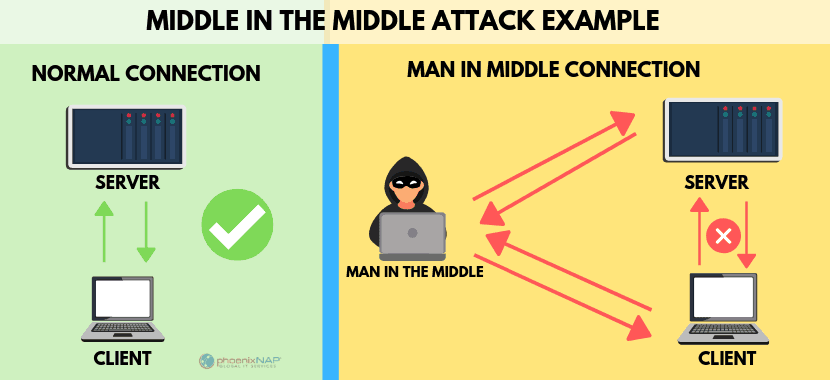
Man in the Middle Attack Prevention
Use a Virtual Private Network (VPN) to encrypt your web traffic. An encrypted VPN severely limits a hacker’s ability to read or modify web traffic.
Be prepared to prevent data loss; have a cyber security incident response plan.
Network Security
Secure your network with an intrusion detection system. Network administrators should be using good network hygiene to mitigate a man-in-the-middle attack.
Analyze traffic patterns to identify unusual behavior.
Your network should have strong firewalls and protocols to prevent unauthorized access.
Use third-party penetration testing tools, software, and HTTPS encryption to help detect and block spoofing attempts.
Install active virus and malware protection that includes a scanner that runs on your system at boot.
MITM attacks often rely on malware. Running updated anti-virus software is imperative.
Secure Your Communications
Encryption is the best defense to protect against intercepted communication.
The most effective method to stop email hijacking is to enable two-factor authentication. That means that, in addition to your password, you have to provide another vector of authentication. One example is Gmail’s combination of a password and a text to your smartphone.
Use basic internet security hygiene on all devices, including mobile applications.
Watch out for phishing emails as they are the most common attack vector. Carefully examine links before clicking.
Only install browser plug-ins from reputable sources.
Minimize the potential of attacks by signing out unused accounts to invalidate session cookies.
Force encryption by typing https at the beginning:https://www.website.com
If you expect an encrypted connection but don’t have one, stop what you’re doing and run a security scan.
If you use Google Chrome, install a chrome security extension, like HTTPS Everywhere, which forces an SSL connection whenever possible.
You should see a green or gray padlock just to the left of the web address in your browser. If you ever see a red padlock, that means there is something wrong with the encryption — double check domain names and your browser before visiting an insecure site.
Disable “Punycode support” (for rendering characters from different languages) on your browser.
Add an enterprise password management solution; this will avoid auto-filling passwords on a nefarious site.
Remember, mobile security best practices. Mobile applications are often targeted.
Avoid using public wifi networks. If you must use public wi-fi, configure your device to require a manual connection.
MITM attacks can be difficult to detect while they are occuring. The best way to stay safe is consistantly implementing all the prevention best practices above.
Be aware that some attacks are a form of social engineering. If something doesn’t seem right about a website or email, take a few minutes to dig a little deeper.
Protect your organization from falling victim
Detecting an attack is difficult, but they can be prevented.
Many Man In TheMiddle attacks can be prevented with good network hygiene, such as firewalls and security protocols. It is important to supplement these efforts by being mindful of your network habits.
Learn how PhoenixNAP proactively manages, detects, and responds to security indicators with our Threat Management Intelligence Services.
Recent Posts
What is Business Continuity Management (BCM)? Framework & Key Strategies
Business continuity management is a critical process. It ensures your company maintains normal business operations during a disaster with minimal disruption.
BCM works on the principle that good response systems mitigate damages from theoretical events.
What is Business Continuity Management? A Definition
Business continuity management is defined as the advanced planning and preparation of an organization to maintaining business functions or quickly resuming after a disaster has occurred. It also involves defining potential risks including fire, flood or cyber attacks.
Business leaders plan to identify and address potential crises before they happen. Then testing those procedures to ensure that they work, and periodically reviewing the process to make sure that it is up to date.
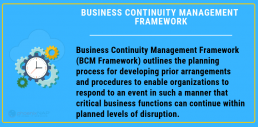
Business Continuity Management Framework
Policies and Strategies
Continuity management is about more than the reaction to a natural disaster or cyber attack. It begins with the policies and procedures developed, tested, and used when an incident occurs.
The policy defines the program’s scope, key parties, and management structure. It needs to articulate why business continuity is necessary andGovernance is critical in this phase.
Knowing who is responsible for the creation and modification of a business continuity plan checklist is one component. The other is identifying the team responsible for implementation. Governance provides clarity in what can be a chaotic time for all involved.
The scope is also crucial. It defines what business continuity means for the organization.
Is it about keeping applications operational, products and services available, data accessible, or physical locations and people safe? Businesses need to be clear about what is covered by a plan whether it’s revenue-generating components of the company, external facing aspects, or some other subset of the total organization.
Roles and responsibilities need to be assigned during this phase as well.
These may be roles that are obvious based on job function, or specific, given the type of disruption that may be experienced. In all cases, the policy, governance, scope, and roles need to be broadly communicated and supported.
Business Impact Assessment
The impact assessment is a cataloging process to identify the data your company holds, where it’s stored, how it’s collected, and how it’s accessed It determines which of those data are most critical and what the amount of downtime is that’s acceptable should that data or apps be unavailable.
While companies aim for 100 percent uptime, that rate is not always possible, even given redundant systems and storage capabilities. This phase is also the time when you need to calculate your recovery time objective, which is the maximum time it would take to restore applications to a functional state in the case of a sudden loss of service.
Also, companies should know the recovery point objective, which is the age of data that would be acceptable for customers and your company to resume operations. It can also be thought of as the data loss acceptability factor.
Risk Assessment
Risk comes in many forms. A Business Impact Analysis and a Threat & Risk Assessment should be performed.
Threats can include bad actors, internal players, competitors, market conditions, political matters (both domestic and international), and natural occurrences. A key component of your plan is to create a risk assessment that identifies potential threats to the enterprise.
Risk assessment identifies the broad array of risks that could impact the enterprise.
Identifying potential threats is the first step and can be far-reaching. This includes:
- The impact of personnel loss
- Changes in consumer or customer preferences
- Internal agility and ability to respond to security incidents with a plan
- Financial volatility
Regulated companies need to factor in the risk of non-compliance, which can result in hefty financial penalties and fines, increased agency scrutiny and the loss of standing, certification, or credibility.
Each risk needs to be articulated and detailed. In the next phase, the organization needs to determine the probability of each risk happening and the potential impact of each one. Likelihood and potential are key measures when it comes to risk assessment.
Once the risks have been identified and ranked, the organization needs to determine what its risk tolerance is for each potentiality. What are the most urgent, critical issues that need to be addressed? At this phase, potential solutions need to be identified, evaluated, and priced. With this new information, which includes probability and cost, the organization needs to prioritize which risks will be addressed.
The ranked risks then need to be evaluated as to which risks will be addressed first. Note that this process is not static. It needs to be regularly discussed to account for new threats that emerge as technologies, geopolitics, and competition evolves.
Validation and Testing
The risks and their impacts need to be continuously monitored, measured and tested. Once mitigation plans are in place, those also should be assessed to ensure they are working correctly and cohesively.
Incident Identification
With business continuity, defining what constitutes an incident is essential. Events should be clearly described in policy documents, as should who or what can trigger that an incident has occurred. These triggering actions should prompt the deployment of the business continuity plan as it is defined and bring the team into action.
Disaster Recovery
What’s the difference between business continuity and disaster recovery? The former is the overarching plans that guide operations and establish policy. Disaster recovery is what happens when an incident occurs.
Disaster recovery is the deployment of the teams and actions that are sprung. It is the net results of the work done to identify risks and remediate them. Disaster recovery is about specific incident responses, as opposed to broader planning.
After an incident, one fundamental task is to debrief and assess the response, and revising plans accordingly.

Role of Communication & Managing Business Continuity
Communication is an essential component of managing business continuity. Crisis communication is one component, ensuring that there are transparent processes for communicating with customers, consumers, employees, senior-level staff, and stakeholders. Consistent communication strategies are essential during and after an incident. Messaging must be consistent, accurate, and coming from a unified corporate voice.
Crisis management involves many layers of communication, including the creation of tools to indicate progress, critical needs, and issues. The types of communication may vary across constituencies but should be based on the same sources of information.
Resilience and Reputation Management
The risks of not having a business continuity plan are significant. The absence of preparing means the company is ill-prepared to address pressing issues.
These risks can leave a company flat-footed and can lead to other significant problems, including:
- Downtime for cloud-based servers, systems, and applications. Even minutes of downtime can result in the loss of substantial revenue.
- Credibility loss to reputation and brand identity. Widespread, consistent, or frequent downtime can erode confidence with customers and consumers. Customer retention can plummet.
- Regulatory compliance can be at risk in industries such as financial services, healthcare, and energy. If systems and data are not operational and accessible, the consequences are severe.
Prepare Today, Establish a Business Continuity Management Program
Managing business continuity is about data protection and integrity, the loss of which can be catastrophic.
It should be part of organizational culture. With a systematic approach to business continuity planning, businesses can expedite the recovery of critical activity.
Recent Posts
The 15 Point Server Maintenance Checklist IT Pros Depend On
Servers are an essential component of any enterprise in 2019. Did you know servers require maintenance like any other equipment?
Keeping a server running is more involved than loading the latest patches and updates. Use our server maintenance checklist to ensure the smooth operation of your server and avoid downtime.
Here’s is our list of 15 server maintenance tips to help you better manage your hardware and avoid the most common issues.
Server Data Verification
1. Double-Check & Verify Your Backups
If you’ve ever had to recover from a catastrophic drive failure, you know how important data is to the smooth operation of a business.
With a good backup strategy, it’s better to have them and not need them, than need them and not have them. Schedule a few minutes every week (or every day) to check the server backups. Alternately, you can mirror the server environment to a virtual machine in the cloud and test it regularly.
2. Check the RAID array
Many dedicated servers run a RAID (Redundant Array of Independent Disks) array. Basically, multiple hard drives acting as one storage device in the event of a single disk failure.
Some types of RAID are designed for performance, others for redundancy. In most cases, modern RAID arrays have advanced monitoring tools. A quick glance at your RAID monitoring utility can alert you to potential drive failures. This lets you plan drive replacements and rebuilds in a way that minimizes downtime.
3. Verify Storage Utilization
Periodically check your server’s hard drive usage. Servers generate a lot of log files, old emails, and outdated software packages.
If it’s important to keep old log files, consider archiving them to external storage. Old emails can also be archived or deleted. Some application updaters don’t remove old files. Fortunately, some package managers have built-in cleanup protocols that you can use. You can also find third-party utilities for managing old software files.
Hard drives are not just used for storage. They also use a swap file, which acts like physical memory. If disk utilization gets above 90%, it can interfere with the swap file, which can severely degrade performance.
Software & Server System Checks
4. Review Server Resource Usage
In addition to reviewing disk space, it’s also smart to watch other server usages.
Memory and processor usage can show how heavily a server is being used. If CPU and memory usage are frequently near 100%, it’s a sign that your server may be overtaxed. Consider reducing the burden on your hardware by upgrading, or by adding additional servers.
5. Update Your Control Panel
Control panel software (such as cPanel) must be updated manually. When updating cPanel, only the control panel is updated. You still need to update the applications that it manages, such as Apache and PHP.
6. Update Software Applications
Depending on your server configuration, you may have many different software applications. Some systems have package managers that can automatically update software. For those that don’t, create a schedule to review available software updates.
This is especially true for web-based applications, which account for the vast majority of breaches. Keep in mind that some operating systems may specifically require older application versions – Python 2 for CentOS7, for example. In cases where you must use older software in a production environment, take care to avoid exposing such software to an open network.
7. Examine Remote Management Tools
Check remote management tools including the remote console, remote reboot, and rescue mode. These are especially important if you run a cloud-based virtual server environment, or are managing your servers remotely.
Check in on these utilities regularly to make sure they are functional. Rebooting can solve many problems on its own. A remote console allows you to log in to a server without being physically present. Rescue mode is a Red Hat solution, but most server operating systems have a management or “safe” mode you can remotely boot to make repairs.
8. Verify Network Utilization
Much like memory and CPU usage, server loads have a network capacity. If your server is getting close to the maximum capacity of the network hardware, consider installing upgrades. In addition to the capacity of the network, you might consider using network monitoring tools. These tools can watch your network traffic for unusual or problematic usage.
Monitoring traffic patterns can help you optimize your web traffic. For example, you might migrate frequently-accessed resources to a faster server. You might also track unusual behavior to identify intrusion attempts and data breaches, and manage them proactively.
9. Verify Operating System Updates
OS updates can be a tricky field to navigate. One the one hand, patches, and updates can resolve security issues, expand functionality, and improve performance. Hackers often plan cybersecurity attacks around “zero-day” exploits. That is, they look at the OS patches that are released, and attack those weaknesses before a business can patch the vulnerability.
On the other hand, custom software can experience conflicts and instability with software updates. Dedicate time regularly to review OS updates. If you have a sensitive production environment, consider creating a test environment to test updates before rolling them out to production.
Server Hardware
10. Physically Clean Server Hardware
Schedule time regularly to physically clean and inspect servers to prevent hardware failure. This helps keep dust and debris out of the circuit boards and fans.
Dust buildup interferes with heat management, and heat is the enemy of server performance. While you’re cleaning, visually inspect the servers and server environment. Make sure the cabinets have plenty of airflow. Check for any unusual wiring of connections. An unexpected flash drive might be a security breach. An unauthorized network cable might create a data privacy concern.
11. Check for Hardware Errors
Modern server operating systems maintain logs of hardware errors.
A hardware error could be a SMART error on a failing hard drive, a driver error for a failing device, or random errors that could indicate a memory problem. Checking your error logs can help you pinpoint and resolve a hardware problem before it escalates to a system crash.
Security Monitoring
12. Review Password Security
Evaluate your password policy regularly. If you are not using an enterprise password management system, start now.
You should have a system that automates good password hygiene. If you don’t, this can be a good time to instruct users to change passwords manually.
13. Evaluate User Accounts
Most businesses have some level of turnover, and it’s easy for user accounts to be overlooked.
Review the user account list periodically, and remove any user accounts no longer needed. You can also check account permissions, to make sure they are appropriate for each user. While reviewing this data, you should also examine client data and accounts. You may need to manually remove data for former clients to avoid legal or security complication
14. Consider Overall Server Security
Evaluate your server security policies to make sure that they are current and functioning. Consider using a third-party network security tool to test your network from the outside. This can help identify areas that you’ve overlooked, and help you prevent breaches before they occur.
15. Check Server Logs Regularly
Servers maintain logs that track access and errors on the server. These logs can be extensive, but some tools and procedures make them easier to manage.
Review your logs regularly to stay familiar with the operation of your servers. A logged error might identify a hardware issue that you can fix before it fails. Anomalies in access logs might mean unauthorized usage by users or unauthorized access from an intruder.
Regular Server Maintenance Reduces Downtime & Failures
With this checklist, you should have a better understanding of how to perform routine server maintenance.
Regular maintenance ensures that minor server issues don’t escalate into a disastrous system failure. Many server failures as a result of preventable situations due to poor planning.
Recent Posts
What is SQL Injection? How to Prevent & Identify an Attack
An SQL Injection – or SQLI is a type of cyber security attack that targets application security weakness and allows attackers to gain control of an application’s database. An attacker inputs a malicious input into an SQL statement., and the SQL server reads it as programming code.
Some SQLI attacks can release lists of sensitive customer data while others delete part (or all) of a database. And some can even remotely run software applications.
SQL Injection attacks are relatively easy and commonplace. Preventing and detecting SQLI attacks is a necessary aspect of security diligence.
How To Prevent SQL Injection
Most experts agree that the best solution is to prevent intrusions before they happen. This can be done by upgrading security combined with vulnerability scanning and penetration testing. Consider using a third party service to check your website for known weaknesses.
Sanitize Input
Also known as validation; this checks the input before it’s executed. This is sort of like putting a bouncer at the front door. An additionally hidden program checks to make sure the input doesn’t contain any SQL executables. The best practice in this solution is to use a whitelist for approved input. Using a whitelist is simpler and more secure than blacklisting unauthorized code.
Parameterized SQL Code
This creates a sort of storage area (a parameter, or a prepared statement) that holds the user input. If an input doesn’t match the type for the parameter, it’s ignored. This technique prevents direct access between a user and the database. Since the user cannot issue commands directly, they cannot inject malicious SQL code.
Use Object-Relational Mapping
ORM libraries are tools for translating between programming languages. This may take help from developers, but it creates a system of virtual objects that run specific SQL queries. Like the previous step, this removes the ability of users to query the SQL server directly.
Limit User Permissions
This is a best practice in all IT and server administration. It holds especially true to preventing SQLI attacks. Simply limit users to the bare minimum permissions they require — the fewer accounts with read-write-execute permissions, the fewer opportunities for exploitation.
Third-Party Security Software
Web Application Firewall software can screen SQL inputs. There are many third-party security tools available. If you don’t have programming skills (or a developer team), consider using software to screen SQL inputs.
How to Detect SQL Injection Attacks
SQLI attacks often look like standard database errors. Without special tools, they can be difficult to detect in real time. An SQLI attack usually involves trial and error. Sometimes, a worm (or bot) repeatedly probes your website for flaws. Sometimes a human hacker enters SQL codes into your website. These attacks don’t always require a login, making detection much more difficult.
Detecting an SQLI attack while it’s in progress requires additional configuration or third-party tools. One method is to examine sqlserver.error_reported event for specific errors. Frequent failed login and bad syntax errors might indicate repeated intrusion attempts. Alternately, the database can be searched for common HTML tags, such as “iframe” or “http-equiv=”refresh.”
A second method to identify an SQLI attack involves traffic analysis. This requires a third party monitoring tool. Over time, the monitor will establish a baseline of standard behavior. If there’s a suspicious change, like changes in permissions, the monitor can trigger an alert.
Auditing software can help after a breach. These tools examine error logs looking for damage that was done. This data can be used to improve security and prevent the next attack.
Typically, these tools monitor:
- Repeated failed logins – These can indicate trial-and-error to bypass SQL security.
- Password changes – Unexpected password changes might indicate a hacker gained access to a user.
- Permission and Ownership changes – Files modified in this way can be evidence that a hacker made the changes to grant themselves access.
- Logins, Logouts, Database operations – While not inherently a sign of intrusion, unusual or unexpected account activity can indicate a breach.
How SQL an Injection Attack Works?
To understand an SQLI attack, it’s helpful to understand an SQL query.
There are two layers to an SQL query on a webpage. The first is user input, like a username and password field. The second is where the hidden programming code creates a SQL query against the database.
A SQL injection attack is when an attacker puts SQL code in a box designed for regular input. This fools an unprotected system into running the string of characters as a programming code.
A simple example works like this:
An attacker decides to attack a SQL server. The server has a prompt for a username and password:
Enter Username: username
Enter Password: password
The server has a database with a table of usernames and passwords. When a user enters their information, the server compares them against the table of usernames and passwords. If the server finds a match for both, the user is granted access.
The hidden program translates the user’s input into a query. A SQL query asks the database for a specific set of information.
A hidden SQL query might look like this:
SELECT UserList.Username
FROM UserList
WHERE UserList.Username = ‘username’
AND UserList.Password = ‘password’
The SQL server is running a query on the UserList table in the database. It’s looking for an entry that matches the ‘username’ input that was entered by the user. But that’s not enough – the database entry also has to contain the ‘password’ input from the user. If both match, the database returns a TRUE result, and the user gains access.
With an SQLI attack, the SQL query can be hacked.
An attacker might enter the following:
Username: username
Enter Password: password’ OR ‘1’=’1
This injects a piece of code into the query. Now, the hidden program creates a database query like this:
SELECT UserList.Username
FROM UserList
WHERE UserList.Username = ‘username’
AND UserList.Password = ‘password’ OR ‘1’=’1’
Note how the last line changed. The contents of the Enter Password field were added to the query. The SQL database reads this as executable code. Now, it’s being asked to check the database whether the number 1is equal to the number 1. It doesn’t matter if the username and password are correct. The formula “1=1” is true, so the database returns a TRUE result, and the user is granted access.
SQL Injection Example
One popular command can be used to delete entire tables from a database:
Enter Username: ‘;DROP TABLE User; ––‘
Enter Password: ‘OR”=’
Once the command is turned into a query, it looks like this:
SELECT UserList.Username
FROM UserList
WHERE UserList.Username = ‘ ‘; DROP TABLE User; ––‘AND Pwd = ‘ ‘ OR”=’
The attacker has injected a piece of code that executes DROP TABLE against the UserList table. Then, the rest of the line is marked as a comment, so it doesn’t run. This would delete the whole UserList table from your database.
SQLI attacks can also be used to run multiple commands. The UNION command can be used to run more than one SELECT:
Enter Username: username
Enter Password: password UNION SELECT Username, Password FROM UserList;
The hidden program would query the database as follows:
SELECT UserList.Username
FROM UserList
WHERE UserList.Username = ‘username’
AND UserList.Password = ‘password’ UNION SELECT Username, Password FROM UserList;
This would return a list of all the usernames and passwords from the table UserList.
This type of attack can wreak havoc.
It can result in data breaches if unauthorized users gain access to user data. It can be used to destroy whole portions of your database. It can even be used to launch and execute malicious software on your server.
SQL Injection Prevention Starts With Being Prepared
SQL Injection attacks don’t require a lot of skill to cause massive damage. Anyone with a computer can look up a SQL exploit and run it against your server, making it a tempting attack vector. Fortunately, they are relatively simple to defend against.
Locking down your SQL server to prevent injection attacks is an important step. It’s a lot easier to prevent an attack than to restore from backup. (Or to notify a client list of a security breach.) Take a moment to evaluate your SQL code.
The Open Web Application Security Project (OWASP) maintains an excellent list of resources and cheat sheets for protecting your SQL servers.
Schedule a security audit. Then sit down with your development team to implement SQLI protection on production servers.
Recent Posts
Upgrade Your Security Incident Response Plan (CSIRP) : 7 Step Checklist
In this article you will learn:
- Why every organization needs a cybersecurity incident response policy for business continuity.
- The Seven critical security incident response steps (in a checklist) to mitigate data loss.
- What should be included in the planning process to ensure business operations are not interrupted?
- Identify which incidents require attention & When to initiate your response.
- How to use threat intelligence to avoid future incidents.
What if your company’s network was hacked today? The business impact could be massive.
Are you prepared to respond to a data security breach or cybersecurity attack? In 2020, it is far more likely than not that you will go through a security event.
If you have data, you are at risk for cyber threats. Cybercriminals are continually developing new strategies to breach systems. Proper planning is a must. Preparation for these events can decrease the damage and loss you and your stakeholder’s.
Having a clear, specific, and current cybersecurity incident response plan is no longer optional.
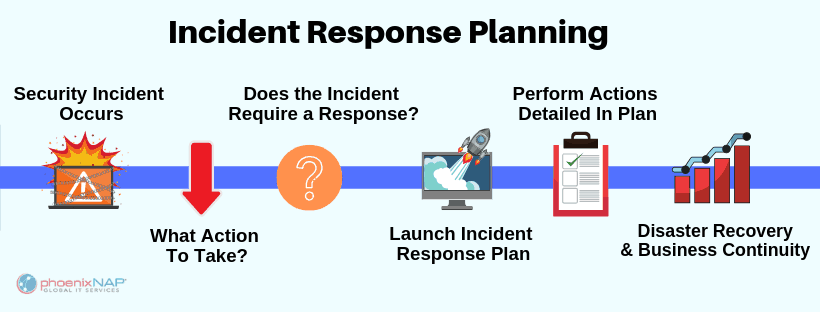
What is an Incident Response Plan?
An incident response (IR) plan is the guide for how your organization will react in the event of a security breach.
Incident response is a well-planned approach to addressing and managing reaction after a cyber attack or network security breach. The goal is to minimize damage, reduce disaster recovery time, and mitigate breach-related expenses.
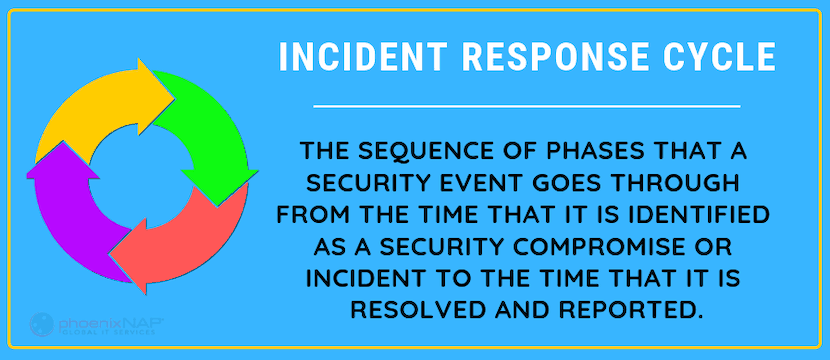
Cybersecurity Incident Response Checklist, in 7 Steps
During a breach, your team won’t have time to interpret a lengthy or tedious action plan.
Keep it simple; keep it specific.
Checklists are a great way to capture the information you need while staying compact, manageable, and distributable. Our checklist is based on the 7 phases of incident response process which are broken down in the infographic below.
Share this Image On Your Site, Copy & Paste
1. Focus Response Efforts with a Risk Assessment
If you haven’t done a potential incident risk assessment, now is the time. The primary purpose of any risk assessment is to identify likelihood vs. severity of risks in critical areas. If you’ve done a cybersecurity risk assessment, make sure it is current and applicable to your systems today. If It’s out-of-date, perform another evaluation.
Examples of a high-severity risk are a security breach of a privileged account with access to sensitive data. This is especially the case if the number of affected users is high. If the likelihood of this risk is high, then it demands specific contingency planning in your IR plan. The Department of Homeland Security provides an excellent Cyber Incident Scoring System to help you assess risk.
Use your risk assessment to identify and prioritize severe, likely risks. Plan appropriately for medium and low-risk items as well. Doing this will help you avoid focusing all your energy on doomsday scenarios. Remember, a “medium-risk” breach could still be crippling.
2. Identify Key Team Members and Stakeholders
Identify key individuals in your plan now, both internal and external to your CSIRT. Name your stakeholders and those with decision-making authority. This could include senior management, customers, and business partners.
Document the roles and responsibilities of each key person or group. Train them to perform these functions. People may be responsible for sending out a PR statement, activating procedures to contact authorities, or performing containment activities to minimize damage from the breach.
Store multiple forms of contact information both online and offline. Plan to have a variety of contact methods available (don’t rely exclusively on email) in case of system interruptions.
3. Define Incident Types and Thresholds
You need to know exactly when to initiate your IT security incident response. Your response plan should define what counts as an incident and who is in charge of activating the plan.
Know the kinds of cybersecurity attacks that can occur — stay-up-to-date on the latest trends and new types of data breaches that are happening.
Defining potential security incidents can save critical time in the early stages of breach detection. The stronger your CSIRT’s working knowledge of incident types and what they look like, the faster you can invoke a targeted active response.
Educate those outside your CSIRT, including stakeholders. They should also be familiar with these incident definitions and thresholds. Establish a clear communication plan to share information amongst your CSIRT and other key individuals to convey this information.
4. Inventory Your Resources and Assets
IR response depends on coordinated action across many departments and groups. You have different systems and resources available, so make the most of all of your departments and response teams.
Create a list of these assets, which can include:
- Business Resources: Team members, security operations center departments, and business partners are all businesses resources. These should consist of your legal team, IT, HR, a security partner, or the local authorities.
- Process Resources: A key consideration is to evaluate the processes you can activate depending on the type and severity of a security breach. Partial containment, “watch and wait” strategies, and system shutdowns like web page deactivation are all resources to include in your IR plan.
Once you have inventoried your assets, define how you would use them in a variety of incident types. With careful security risk management of these resources, you can minimize affected systems and potential losses.
5. Recovery Plan Hierarchies and Information Flow
Take a look at your assets above.
What are the steps that need to happen to execute different processes? Who is the incident response manager? Who is the contact for your security partner?
Design a flowchart of authority to define how to get from Point A to Point B. Who has the power to shut down your website for the short term? What steps need to happen to get there?
Flowcharts are an excellent resource for planning the flow of information. NIST has some helpful tools explaining how to disseminate information accurately at a moment’s notice. Be aware that this kind of communication map can change frequently. Make special plans to update these flowcharts after a department restructure or other major transition. You may need to do this outside your typical review process.
6. Prepare Public Statements
Security events can seriously affect an organizations reputation. Curbing some of the adverse effects around these breaches has a lot to do with public perception. How you interface with the public about a potential incident matters.
Some of the best practices recognized by the IAPP include:
- Use press releases to get your message out.
- Describe how (and with whom) you are solving the problem and what corrective action has been taken.
- Explain that you will publish updates on the root cause as soon as possible.
- Use caution when talking about actual numbers or totalities such as “the issue is completely resolved.”
- Be consistent in your messaging
- Be open to conversations after the incident in formats like Q&A’s or blog posts
Plan a variety of PR statements ahead of time. You may need to send an email to potentially compromised users. You may need to communicate with media outlets. You should have statement templates prepared if you need to provide the public with information about a breach.
How much is too much information? This is an important question to ask as you design your prepared PR statements. For these statements, timing is key – balance fact-checking and accuracy against timeliness.
Your customers are going to want answers fast, but don’t let that rush you into publishing incorrect info. Publicizing wrong numbers of affected clients or the types of data compromised will hurt your reputation. It’s much better to publish metrics you’re sure about than to mop up the mess from a false statement later.
7. Prepare an Incident Event Log
During and after a cybersecurity incident, you are going to need to track and review multiple pieces of information. How, when, and where the breach was discovered and addressed? These details and all supporting info will go into an event log. Prepare a template ahead of time, so it is easy to complete.
This log should include:
- Location, time, and nature of the incident discovery
- Communications details (who, what, and when)
- Any relevant data from your security reporting software and event logs
After an information security incident, this log will be critical. A thorough and effective incident review is impossible without a detailed event log. Security analysts will lean on this log to review the efficacy of your response and lessons learned. This account will also support your legal team and law enforcement both during and after threat detection.
How Often Should You Review Your Incident Response Procedures?
To review the steps in your cybersecurity incident response checklist, you need to test it. Run potential scenarios based on your initial risk assessment and updated security policy.
Perhaps you are in a multi-user environment prone to phishing attacks. Your testing agenda will look different than if you are a significant target for a DDoS attack. At a minimum, annual testing is suggested. But your business may need to conduct these exercises more frequently.
Planning Starts Now For Effective Cyber Security Incident Response
If you don’t have a Computer Security Incident Response Team (CSIRT) yet, it’s time to make one. The CSIRT will be the primary driver for your cybersecurity incident response plan. Critical players should include members of your executive team, human resources, legal, public relations, and IT.
Your plan should be a clear, actionable document that your team can tackle in a variety of scenarios, whether it’s a small containment event or a full-scale front-facing site interruption.
Protecting your organization from cybersecurity attacks is a shared process.
Partnering with the experts in today’s security landscape can make all the difference between a controlled response and tragic loss. Contact PhoenixNAP today to learn more about our global security solutions.
Recent Posts
What Is Penetration Testing? Types and Techniques
Security should be a multi-layered approach. One of those critical layers is Penetration Testing.
Is your data safe in today’s rapidly changing world of cybersecurity attacks?
The best way to find out if application systems are secure is to attempt to hack them yourself. A tried and tested method is a penetration test, a form of application scanning. Vulnerability detection aims to identify potential weakness before the bad guys do
In this article, we will discuss what pen testing is, different types, and how your organization can benefit from it.
What is Penetration Testing? A Definition
By definition, penetration testing is a method for testing a web application, network, or computer system to identify security vulnerabilities that could be exploited. The primary objective for security as a whole is to prevent unauthorized parties from accessing, changing, or exploiting a network or system. It aims to do what a bad actor would do.
Consider a Pen Test an authorized simulation of a real-world attack on a system, application, or network to evaluate the security of the system. The goal is to figure out whether a target is susceptible to an attack. Testing can determine if the current defense systems are sufficient, and if not, which defenses were defeated.
These tests are designed to target either known vulnerabilities or common patterns which occur across applications — finding not only software defects but also weaknesses in network configurations.
Why Security Penetration Testing is Important
A pen-test attempts to break a security system. If a system has sufficient defenses, alarms will be triggered during the test. If not, the system is considered compromised. Penetration testing tools are used to monitor and improve information security programs.
Though system administrators need to know the difference between a test and an actual threat, it’s important to treat each inspection as a real-world situation. Though unlikely, credible security threats could occur during the test.
Penetration tests are often creative rather than systematic. For example, instead of a brute force attack of a network, a pen-test could be designed to infiltrate a company executive via his/her e-mail. Approaching the problem creatively as an infiltrator is more realistic with what could potentially be a real attack someday.
Once a test is complete, the InfoSec team(s) need to perform detailed triage to eliminate vulnerabilities or defer action where a weakness poses little or no threat.
Typically, penetration testers are external contractors hired by organizations. Many organizations also offer bounty programs. They invite freelance testers to hack their external-facing systems, such as public websites, in a controlled environment with the promise of a fee (or other forms of compensation) to breach an organization’s computer systems.
There is a good reason why organizations prefer to hire external security professionals. Those who do not know how an application was developed may have a better chance of discovering bugs the original developers may never have considered or maybe blind toward.
Penetration testers come from a variety of backgrounds. Sometimes these backgrounds are similar to those of software developers. They can have various forms of computer degrees (including advanced ones), and they can also have specialized training in penetration security testing. Other penetration testers have no relevant formal education, but they have become adept at discovering security vulnerabilities in computer software. Still, other penetration testers were once criminal hackers, who are now using their advanced skills to help organizations instead of hurting them.

Steps of Penetration Testing
Reconnaissance and Intelligence Gathering
Before explaining the different methods for a penetration test, it’s necessary to understand the process of gathering intelligence from systems and networks.
Intelligence gathering, or Open Source Intelligence (OSINT) gathering, is a crucial skill for testers. During this initial phase, ethical hackers or cybersecurity personnel learn how the environment of a system functions, gathering as much information as possible about the system before beginning.
This phase will usually uncover surface-level vulnerabilities.
It includes a scan of:
- The local and wireless network
- Pertinent applications
- Website
- Cloud-based systems
- Employees
- Physical hardware facilities
Threat Modeling
After gathering intelligence, cybersecurity professionals move on to threat modeling.
Threat modeling is a structured representation of the information that affects system security. Security teams use this type of model to treat every application or feature as if it were a direct safety.
Threat modeling captures, organizes, and analyzes the bulk of intelligence gathered in the previous preparation phase for a penetration test. It then makes informed decisions about cybersecurity while prioritizing a comprehensive list of security improvements, including concepts, requirements, design, and rapid implementation.
Threat modeling is a process of its own, and can be summed up by asking the following four questions:
- What are we working on?
- What can go wrong with what we’re working on?
- What can we do to ensure that doesn’t happen?
- Did we completely eradicate the problem?
There is no single, right way to investigate vulnerabilities in a system. But combinations of these questions can go a long way toward finding solutions.
Cybersecurity professionals define and identify vulnerability assessment scope, threat agents, existing countermeasures, exploitable vulnerabilities, prioritized risks, and possible countermeasures during threat modeling.

Types of Penetration Testing
Following intelligence gathering and threat modeling, a penetration test itself is the next process.
Below are various penetration testing methodologies. It’s important to test for as many potential weaknesses throughout your system and network as possible.
Conducting multiple tests can reveal more vulnerabilities and provide your security and IT teams with more opportunities to address and eliminate security threats.
Network Penetration Testing & Exploitation
This type of test includes both internal and external network exploitation testing through the emulation of hacker techniques that penetrate a system’s network defenses. Once the network has been compromised, the tester can potentially gain access to the internal security credentials of an organization and its operation.
Testing of a network includes identifying:
- Threat Modeling
- Vulnerability Scanning & Analysis
- Firewall bypassing
- Router and proxy server testing
- IPS and DPS evasion
- Open port scanning
- SSH security attacks
Network testing is more in-depth than standard penetration testing and locates vulnerabilities that basic scans may not find, all to create a safer overall network.
Web Application Security Tests
Application security tests search for server-side application vulnerabilities. The penetration test is designed to evaluate the potential risks associated with these vulnerabilities through web applications, web services, mobile applications, and secure code review.
The most commonly reviewed applications are web apps, languages, APIs, connections, frameworks, systems, and mobile apps.
Client Side or Website & Wireless Network
Wireless and website tests inspect relevant devices and infrastructures for vulnerabilities that may compromise and exploit the wireless network.
Recently, Mathy Vanhoef, a security expert at the Belgian University KU Leuven, determined that all WiFi networks are vulnerable to hacking through their WPA2 protocols.
This exploit can reveal all encrypted information, including credit card numbers, passwords, chat messages, emails, and images. Injection and manipulation of data are also possible, leading to the potential for ransomware or malware attacks that could threaten the entire system.
To prevent wireless network hacking, check for the following during pen testing:
- webserver misconfiguration including the use of default passwords
- malware and DDoS attacks
- SQL injections
- MAC address spoofing
- media player or content creation software testing vulnerabilities
- cross-site scripting
- unauthorized hotspots and access points
- wireless network traffic
- encryption protocols
Social Engineering Attacks
Social engineering tests search for vulnerabilities an organization could be exposed to based on its employees directly. In this case, creative testing must be designed to mimic real-world situations that employees could run into without realizing they’re being exploited.
These tests not only help with internal security strategy amongst co-workers but allow security teams to determine necessary next steps in cybersecurity.
Specific topics such as eavesdropping, tailgating, or phishing attacks; posing as employees; posing as vendors/contractors; name-dropping or pretexting; gifts or dumpster diving; bluesnarfing; quid pro quo; or baiting, are common testing practices.
Bad actors typically possess social engineering skills and can influence employees to create access to systems or sensitive customer data. When used in conjunction with other physical tests, social engineering testing can help to develop a culture of security throughout an organization.
Physical Testing
Physical penetration testing prevents hackers from gaining tangible access to systems and servers by ensuring that facilities are impenetrable by unauthorized personnel. IT and cybersecurity professionals focus primarily on system vulnerabilities and may overlook physical security aspects that can result in exploitation. Physical penetration tests focus on attempts to access facilities and hardware through RFID systems, door entry systems and keypads, employee or vendor impersonation, and evasion of motion and light sensors.
Physical tests are used in combination with social engineering such as manipulation and deceit of facility employees to gain system access.
Computer Network Exploitation (CNE) & Computer Network Attacks (CNAs)
In a Computer Network Exploitation (CNE), networks can be used to target other systems directly.
For example, attempting to extract and obtain sensitive information and data such as classified intelligence or government documents. This type of attack is commonly performed within government agencies and military organizations and is considered surveillance, wiretapping, or even cyber-terrorism.
In a Computer Network Attacks (CNAs), the goal is to destroy or corrupt information that exists on a victim’s network through an Electronic Attack (EA). EA’s can use techniques such as an electromagnetic pulse (EMP) designed to incapacitate a network or system.
Types of CNAs can overlap with social engineering and include data modification and IP address spoofing; password-based attacks; DDOS; Man in the middle attacks; or compromised key, sniffer, and application layer attacks.
Cloud Pen Testing
Cloud services are essential for group collaboration, networking, and storage. Large amounts of data are stored within the cloud, which means that it is a hotbed for hackers seeking to exploit this technology.
Cloud deployment is relatively simple. However, cloud providers often have a shared or hands-off approach to cybersecurity, and organizations are responsible for vulnerabilities testing or hacking prevention themselves.
Cloud penetration testing is a complicated test, but one that is necessary and important.
Typical cloud testing areas include:
- Weak passwords
- Network Firewalls
- RDP and SSH remote administration
- Applications and encryption
- API, database, and storage access; VMs; and unpatched operating systems.
Public cloud penetration testing can be among the most complicated to perform.
Utilize a “white box” method of testing by making use of as much information as possible about the target system. This includes the software it runs, and the network architecture, source code.
This will ensure you have the intelligence to accomplish the test. Be aware that public cloud services providers limit your penetration testing abilities due to the resource limitations of shared infrastructures.
For instance, Amazon Web Services (AWS) requires that you fill out the AWS Vulnerability Testing Request Form before testing and forbids certain types of pen tests.
Microsoft Azure lists its Microsoft Cloud Unified Penetration Testing Rules of Engagement on its website.
On-premises subscribers and cybersecurity personnel can scan applications, data, runtime, operating system, virtualization, servers, storage, and networking.
In the cloud, they can test applications, data, runtime, and operating systems for IaaS; applications and data only for PaaS; and no subscriber testing for SaaS.
Assess Your Security With Pen Testing Before a Hacker Does
Cybersecurity is a concern for all businesses. Constant threats to IT systems and networks are non-stop. Identifying weaknesses thru testing can prevent unauthorized parties from accessing data. Ensure that your applications and network systems have an evolving multi-stage security approach.
Designing tests that simulate attacks on hardware, software, networks, and even your employees, you can quickly determine the weaknesses.
Recent Posts
What is Spear Phishing? Learn How to Prevent Attacks
The latest numbers are in, and they aren’t pretty. In 2018, over 90% of cyber attacks and their resulting breaches stemmed from a spear phishing email.
According to SANS Institute’s Allen Paller, spear phishing emails caused 95% of all attacks on enterprise networks. So what is it that makes phishing emails in general and spear phishing emails in specific so dangerous? And how can individuals and enterprises protect themselves against such an invasive tactic?
The following article details what spear phishing attacks are and how to prevent them.
A Definition of Spear Phishing
Spear phishing is a much more targeted type of phishing attack. Here, the perpetrator doesn’t just send out a stock email to thousands or tens of thousands of recipients. Instead, they send out a personalized email to each of their targets. That email is sent out only after the perpetrator has done their research and knows specific details about their victim that will encourage the target to act. Those key details enable the perpetrator to draft the email in such a way as to instill trust in their victim and encourage them to do something that they might not otherwise do.
Spear phishing attacks usually appeal either to human greed or fear. This means they will either offer targets money, discounts, bargains, etc. or threaten targets into acting by saying their checking, PayPal, or eBay account has been frozen.
To encourage their victim to act, the perpetrator of a spear phishing attack will first find their victim and collect critical details to ensure whichever tactic will be believable. For example, they might search out an individual’s profile on a social networking site and from there glean their target’s email address, geographic location, workplace, friends list, and any new big items recently purchased and from where. Such details alone might seem innocuous but together enable the perpetrator to craft a dangerously effective email.
In their spear phishing email, the perpetrator will use the information to pose as a friend, colleague, boss, or other familiar entity to send out a highly convincing but ultimately fraudulent message. Hackers also employ a blend of email spoofing, and dynamic URLs to make emails appear more convincing.
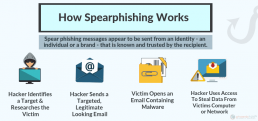
91% of cyberattacks and the resulting data breach begin with a “spear phishing” email, according to research from security software firm Trend Micro.
How Spear Phishing Works
Phishing schemes are any cyber or phone-based schemes designed to trick a victim into giving up personal details.
That information is then later used in some sort of scam. It’s a common hack, and most phishing scheme perpetrators target thousands of people with the goal of fooling a few. Take for example the famous “Nigerian Prince” scam. In this phishing scam, thousands of people receive emails offering a large sum of money on the condition the recipient transfers money for them. Most people will delete the email, but every year there continues to be those who don’t. Those victims who fall prey can lose thousands or even tens of thousands of dollars to the scam.
However, because more people have become aware of such scams and because business IT groups and email servers have tightened up security, the phishers have become more specialized. This is where the hacking technique of spear phishing developed.
Examples of Spear Phishing
Examples and scenarios for how spear phishing works and what it looks like include:
Spear Phishing An Individual: The perpetrator discovers the bank their target uses and using a spoofed email and copied website credentials, sends the target an email stating the account has been breached. That email will use fear-mongering to get the target to call a number or follow a link to provide confidential banking information (such as username and password) to confirm they are the real account holder. The perpetrator will then use that information to siphon out money.
Spear Phishing a business: A spear phishing attack against a company is similar to the one against an individual in that the perpetrator will first research and then use that research to draft a legitimate-looking scam. But the difference is the scale. Networking firm Ubiquiti Networks Inc. learned this the hard when cyber thieves uncovered key details about firm executives. The thieves then used those details to create spoof communications that appeared as though they were the firm executives and directed the firm’s finance department to initiate unauthorized international wire transfers to the tune of $46.7 million.
5 Protection Tactics To Avoid Spear Phishing Attacks
Spear phishing attacks look legitimate but are very dangerous. The following are a few tips both individuals and businesses can use to help prevent perpetrators of such attacks both from harvesting key data and using the data to get hold of critical accounts:
1. Avoid posting personal information online, such as a personal phone number. Every individual should avoid ever posting their phone number on their social media platform and avoid inputting their phone number with an unknown (and even most known) websites and mobile applications. Phone numbers are just as key to identifying a person and their complete financial background as a social security number. With techniques like SIM swapping and phishing scams, a person can essentially take over all of a person’s financial accounts.
2. Never click an unknown email link or attachment, especially from a financial or business institution. Use email security best practices. Perpetrators of spear phishing attacks will commonly send emails posing as a trusted institution their victim is known to frequent, such as Bank of America, Amazon, and eBay. Any emails an individual receives via personal business email should not be wholly trusted. Never click a link from such an organization, instead launch a separate browser window and go directly to the institution’s website to investigate claims and conduct business as usual. Any other emails, from friends, favorite blog writers, or nonprofit organizations, should be considered with care. Check the anchor text and never input personal details or otherwise confidential information on a link clicked from an email.
3. Be careful over-sharing on social media. Be mindful of personal details on their social media profiles and who they allow access to it. Keep privacy configurations high and avoid accepting unknown friend requests.
4. All organizations should implement a wholescale data protection program. Data protection programs are a combination of user education and security awareness training on best digital security practices and the implementation of a wholesale cyber protection solution designed to prevent potential data loss due to cyber attacks like spear phishing.
5. Keep confidential information out of emails. A favorite spear phishing tactic is to email employees from a reputable looking address and request sensitive information such as passwords or business banking details.ion.
Stay Alert & Stay Safe
No person and no organization is immune to becoming a target of cyber thieves.
If your information is on the internet or your smartphone has applications downloaded, then you are a potential target for this and other sophisticated cyber attacks. The best way to prevent falling victim is to stay aware at all time.
Keep information confidential, never trust outside sources and contact an experienced and professional security solutions team to ensure business assets are likewise protected.
Recent Posts
17 Types of Cyber Attacks To Secure Your Company From in 2020
In this article you will learn:
- What a Cyber Security Attack looks like in 2020 and how to identify one.
- An attack could destroy your business overnight, a proper security defense requires understanding the offense.
- How to protect your organization from the most common cyber attack vectors. Different methods require different prevention strategies.
- In the event an attack happens, learn how to be prepared to respond and respond.
What is a Cyber Attack?
A cyber attack is an intentional exploitation of computer systems, networks, and technology-dependent enterprises. These attacks use malicious code to modify computer code, data, or logic. Culminating into destructive consequences that can compromise your data and promulgate cybercrimes such as information and identity theft. A cyber attack is also known as a computer network attack (CNA).
Common Types of Cybersecurity Attacks
Phishing Attacks
Phishing is a type of social engineering usually employed to steal user data such as credit card numbers and login credentials. It happens when an attacker, posing as a trusted individual, tricks the victim to open a text message, email, or instant message. The victim is then deceived to open a malicious link that can cause the freezing of a system as part of a ransomware attack, revealing sensitive information, or installation of malware.
This breach can have disastrous results. For an individual, this includes identity theft, stealing of funds, or unauthorized purchases.
Phishing is often used to obtain a foothold in governmental or corporate networks as part of a more significant plot such as an advanced persistent threat (APT). In such a case, employees are compromised to gain privileged access to secured data, distribute malware in a closed environment, and to bypass security parameters.
Learn more about phishing attacks.
Spear Phishing Attacks
Spear phishing is an email aimed at a particular individual or organization, desiring unauthorized access to crucial information. These hacks are not executed by random attackers but are most likely done by individuals out for trade secrets, financial gain, or military intelligence.
Spear phishing emails appear to originate from an individual within the recipient’s own organization or someone the target knows personally. Quite often, government-sponsored hacktivists and hackers perform these activities. Cybercriminals also carry out these attacks with the aim of reselling confidential data to private companies and governments. These attackers employ social engineering and individually-designed approaches to effectively personalize websites and messages.
Learn more about spear phishing attacks.
Whale Phishing Attack
A whale phishing attack is a type of phishing that centers on high-profile employees such as the CFO or CEO. It is aimed at stealing vital information since those holding higher positions in a company have unlimited access to sensitive information. Most whaling instances manipulate the victim into permitting high-worth wire transfers to the attacker.
The term whaling signifies the size of the attack, and whales are targeted depending on their position within the organization. Since they are highly targeted, whaling attacks are more difficult to notice compared to the standard phishing attacks.
In a business, system security administrators can lessen the effectiveness of such a hack by encouraging the corporate management staff to attend security awareness training.
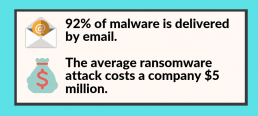
Malware Attacks
Malware is a code that is made to stealthily affect a compromised computer system without the consent of the user. This broad definition includes many particular types of malevolent software (malware) such as spyware, ransomware, command, and control.
Many well-known businesses, states, and criminal actors have been implicated of and discovered deploying malware.
Malware differs from other software in that it can spread across a network, cause changes and damage, remain undetectable, and be persistent in the infected system. It can destroy a network and bring a machine’s performance to its knees.
Ransomware
Ransomware blocks access to a victims data, typically threating delete it if a ransom is paid. There is no guarantee that paying a ransom will regain access to the data. Ransomware is often carried out via a Trojan delivering a payload disguised as a legitimate file.
Learn more about ransomware attacks and how to prevent them.
Drive-by Attack
A drive-by attack is a common method of distributing malware.
A cyber attacker looks for an insecure website and plants a malicious script into PHP or HTTP in one of the pages. This script can install malware into the computer that visits this website or become an IFRAME that redirects the victim’s browser into a site controlled by the attacker. In most cases, these scripts are obfuscated, and this makes the code to be complicated to analyze by security researchers. These attacks are known as drive-by because they don’t require any action on the victim’s part except visiting the compromised website. When they visit the compromised site, they automatically and silently become infected if their computer is vulnerable to the malware, especially if they have not applied security updates to their applications.
Trojan Horses
A Trojan is a malicious software program that misrepresents itself to appear useful. They spread by looking like routine software and persuading a victim to install. Trojans are considered among the most dangerous type of all malware, as they are often designed to steal financial information.
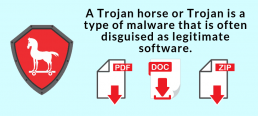
Web Attacks
SQL Injection
SQL injection, also known as SQLI, is a kind of attack that employs malicious code to manipulate backend databases to access information that was not intended for display. This may include numerous items including private customer details, user lists, or sensitive company data.
SQLI can have devastating effects on a business. A successful SQLI attack can cause deletion of entire tables, unauthorized viewing of user lists, and in some cases, the attacker can gain administrative access to a database. These can be highly detrimental to a business. When calculating the probable cost of SQLI, you need to consider the loss of customer trust in case personal information like addresses, credit card details, and phone numbers are stolen.
Although SQLI can be used to attack any SQL database, the culprits often target websites.
Cross Site Scripting
Cross-site scripting (XSS) is a kind of injection breach where the attacker sends malicious scripts into content from otherwise reputable websites. It happens when a dubious source is allowed to attach its own code into web applications, and the malicious code is bundled together with dynamic content that is then sent to the victim’s browser.
Malicious code is usually sent in the form of pieces of Javascript code executed by the target’s browser. The exploits can include malicious executable scripts in many languages including Flash, HTML, Java, and Ajax. XSS attacks can be very devastating, however, alleviating the vulnerabilities that enable these attacks is relatively simple.
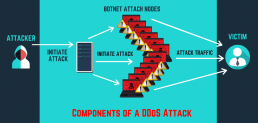
Other Types of Cyber Security Threats
Distributed Denial-of-Service (DDoS) attack?
Denial-of-service (DDoS) aims at shutting down a network or service, causing it to be inaccessible to its intended users. The attacks accomplish this mission by overwhelming the target with traffic or flooding it with information that triggers a crash. In both situations, the DoS onslaught denies legitimate users such as employees, account holders, and members of the resource or service they expected.
DDoS attacks are often targeted at web servers of high-profile organizations such as trade organizations and government, media companies, commerce, and banking. Although these attacks don’t result in the loss or theft of vital information or other assets, they can cost a victim lots of money and time to mitigate. DDoS is often used in combination to distract from other network attacks.
Learn more about DDoS Attacks.
Password Attack
A password attack simply means an attempt to decrypt or obtain a user’s password with illegal intentions.
Crackers can use password sniffers, dictionary attacks, and cracking programs in password attacks. There are few defense mechanisms against password attacks, but usually, the remedy is inculcating a password policy that includes a minimum length, frequent changes, and unrecognizable words.
Password attacks are often carried out by recovering passwords stored or exported through a computer system. The password recovery is usually done by continuously guessing the password through a computer algorithm. The computer tries several combinations until it successfully discovers the password.
Eavesdropping Attack
Eavesdropping attacks start with the interception of network traffic.
An Eavesdropping breach, also known as snooping or sniffing, is a network security attack where an individual tries to steal the information that smartphones, computers and other digital devices send or receive This hack capitalizes on unsecured network transmissions to access the data being transmitted. Eavesdropping is challenging to detect since it doesn’t cause abnormal data transmissions.
These attacks target weakened transmissions between the client and server that enables the attacker to receive network transmissions. An attacker can install network monitors such as sniffers on a server or computer to perform an eavesdropping attack and intercept data as it is being transmitted. Any device within the transmitting and receiving network is a vulnerability point, including the terminal and initial devices themselves. One way to protect against these attacks is knowing what devices are connected to a particular network and what software is run on these devices.
Birthday attack
The birthday attack is a statistical phenomenon that simplifies the brute-forcing of one-way hashes. It is based on the birthday paradox that states that for a 50 percent chance that someone shares your birthday in any room, you need 253 individuals in the room. However, for a chance higher than 50 percent, you only require 23 people. This probability works because these matches depend on pairs. If you choose yourself as one of the pairs, you only need 253 people to get the required number of 253 pairs. However, if you just need matches that don’t include you, you only need 23 people to create 253 pairs when cross-matching with each other. Thus, 253 is the number you need to acquire a 50 percent probability of a birthday match in a room.
Brute-Force and Dictionary Network Attacks
Dictionary and brute-force attacks are networking attacks whereby the attacker attempts to log into a user’s account by systematically checking and trying all possible passwords until finding the correct one.
The simplest method to attack is through the front door since you must have a way of logging in. If you have the required credentials, you can gain entry as a regular user without creating suspicious logs, needing an unpatched entry, or tripping IDS signatures. If you have a system’s credentials, your life is even simplified since attackers don’t have these luxuries.
The term brute-force means overpowering the system through repetition. When hacking passwords, brute force requires dictionary software that combines dictionary words with thousands of different variations. It is a slower and less glamorous process. These attacks start with simple letters such as “a” and then move to full words such as “snoop” or “snoopy.”
Brute-force dictionary attacks can make 100 to 1000 attempts per minute. After several hours or days, brute-force attacks can eventually crack any password. Brute force attacks reiterate the importance of password best practices, especially on critical resources such as network switches, routers, and servers.
Learn more about Brute Force attacks.
Insider Threats
Not every network attack is performed by someone outside an organization.
Inside attacks are malicious attacks performed on a computer system or network by an individual authorized to access the system. Insiders that carry out these attacks have the edge over external attackers since they have authorized system access. They may also understand the system policies and network architecture. Furthermore, there is less security against insider attacks since most organizations focus on defending against external attacks.
Insider threats can affect all elements of computer security and range from injecting Trojan viruses to stealing sensitive data from a network or system. The attackers may also affect the system availability by overloading the network or computer processing capacity or computer storage, resulting in system crashes.
Man-in-the-Middle (MITM) Attacks
Man-in-the-middle (MITM) attacks are a type of cybersecurity breach that allows an attacker to eavesdrop a communication between two entities. The attack occurs between two legitimate communicating parties, enabling the attacker to intercept communication they should otherwise not be able to access. Thus the name “man-in-the-middle.” The attacker “listens” to the conversation by intercepting the public key message transmission and retransmits the message while interchanging the requested key with his own.
The two parties seem to communicate as usual, without knowing the message sender is an unknown perpetrator trying to modify and access the message before it is transmitted to the receiver. Thus, the intruder controls the whole communication.
AI-Powered Attacks
The concept of a computer program learning by itself, building knowledge, and getting more sophisticated may be scary.
Artificial intelligence can be easily dismissed as another tech buzzword. However, it is already being employed in everyday applications through an algorithmic process referred to as machine learning. Machine learning software is aimed at training a computer to perform particular tasks on its own. They are taught to accomplish tasks by doing them repeatedly while learning about certain obstacles that could hinder them.
AI can be used to hack into many systems including autonomous vehicles and drones, converting them into potential weapons. AI makes cyber attacks such as identity theft, password cracking, and denial-of-service attacks, automated, more powerful and efficient. It can also be used to kill or injure people, steal money, or cause emotional harm. Larger attacks can as well be used to affect national security, shut down hospitals, and cut power supplies to entire regions.
Be Prepared For Attacks On Your Network
This article has reviewed the top cyber-security attacks that hackers use to disrupt and compromise information systems.
For you to mount a good defense mechanism, you need to understand the offense. This review of the most common cyber attacks shows you that attackers have many options while choosing attacks to compromise and disrupt information systems. You also need to be proactive in defending and securing your network.
Maintain an updated antivirus database, train your employees, keep your passwords strong, and use a low-privilege IT environment model to protect yourself against cyber attacks.
Recent Posts
HIPAA Compliant Cloud Storage Solutions: Maintain Healthcare Compliance
Hospitals, clinics, and other health organizations have had a bumpy road towards cloud adoption over the past few years. The implied security risks of using the public cloud or working with a third-party service provider considerably delayed cloud adoption in the healthcare industry.
Even today, when 84% of healthcare organizations use cloud services, the question of choosing the right HIPAA compliant cloud provider can be a headache.
All healthcare providers whose clients’ data is stored in the U.S. are a subject to a set of regulations known as HIPAA compliance
Today, any organization that handles confidential patient data needs abide by HIPAA storage requirements.
What is HIPAA Compliance?
HIPAA standards provide protection of health data. Any vendor working with a healthcare organization or business handling health files must abide by the HIPAA privacy rules. There are also many ancillary industries that must adhere to the guidelines if they have access to medical and patient data. This is where HIPPA Compliant cloud storage plays a significant role.
In 1996, “the U.S. Department of Health and Human Services (“HHS”) issued the Privacy Rule to implement the requirement of the Health Insurance Portability and Accountability Act (HIPAA) of 1996.” The Privacy Rule addresses patients’ “electronic protected health information” and how organizations, or “HIPAA covered entities” subject to the Privacy Rules must comply.
Most healthcare institutions use some form of electronic devices to provide medical care. This means that information no longer resides on a paper chart, but on a computer or in the cloud. Unlike general businesses or most commercial entities, healthcare institutions are legally obliged to employ the most reliable data backup practices.
So, how does this affect their choice of a cloud provider?
When planning their move to cloud computing, health care institutions need to ensure their vendor meets specific security criteria.
These criteria translate into requirements and thresholds that a company must meet and maintain to become HIPAA-ready. These come down to a set of certifications, SOC auditing and reporting, encryption levels, and physical security features.
HIPAA cloud storage solutions should work to make becoming compliant simple and straightforward. This way, healthcare organizations have one less thing to worry about and can focus on improving their critical processes.

HIPAA Cloud Storage and Data Backup Requirements
A cloud service provider doing business with a company operating under the HIPAA-HITECH act rules is considered a business associate. As such, it must show that it within cloud compliance standards and follows any relevant standards. Although the vendor does not directly handle patient information, it does receive, manage, and store Protected Health Information (PHI). This fact alone makes them responsible for protecting it according to HIPAA-HITECH act guidelines.
Being HIPAA compliant means implementing all of the rules and regulations that the Act proposes. Any vendor offering services that are subject to the act must provide documentation as proof of their conformity. This documentation needs to be sent not only to their clients but also to the Office for Civil Rights (OCR). The OCR is a sub-agency of the U.S. Department of Education, which promotes equal access to healthcare and human services programs.
Healthcare industry organizations looking to work with a HIPAA Compliant cloud storage provider should request proof of compliance to protect themselves. If the provider follows all standards, it should have no qualms about sharing the appropriate documentation with you.
HIPAA requirements for cloud hosting organizations are the same as the requirements for business associates. They fall into three distinct categories: administrative, physical, and technical safeguards.
- Administrative Safeguards: These types of safeguards are transparent policies that outline how the business will comply from an operational standpoint. The operations can include managing security risk assessments, appropriate procedures, disaster and emergency response, and managing passwords.
- Physical Safeguard: Physical safeguards are usually systems that are in place to protect customer data. They might include proper storage, data backup, and appropriate disposal of media at a data center. Important security precautions for facilities where hardware or software storage devices reside are also a part of this category.
- Technical Safeguards: This group of safeguards refers to technical features implemented to minimize data risk and maximize protection. Requiring unique login information, auto-logoff policies, and authentication for PHI access are just some of the technical safeguards that should be in place.

What Makes a HIPAA Certified Cloud Provider Compliant?
Providing HIPAA compliant file storage hardware or software is not as simple as flipping a switch. It takes a tremendous amount of time and effort for a company to become compliant.
The critical element to look for in a HIPAA certified cloud storage provider is its willingness to make a Business Associate Agreement. Known as a BAA, this agreement is completed between two parties planning to transmit, process, or receive PHI. Its primary purpose is to protect both parties from any legal repercussions resulting in the misuse of protected health information.
A Business Associate Agreement BAA must not add, subtract, or contradict the overall standards of the HIPAA. However, if both parties agree, supplementing specific terminology is acceptable. There are also some core terms that make up the groundwork for a compliant business associate agreement and must remain for the contract to be considered legally binding.
The level of encryption enabled by the cloud provider needs proper attention. The company should be encrypting files not only in transit but also at rest. Advanced Encryption Standard (AES) is the minimum level of encryption that it should use for file storage and sharing. AES is a successor to Data Encryption Standard (DES) and was developed by the National Institute of Standards and Technology (NIST) in 1997. It is an advanced encryption algorithm that offers improved defense against different security incidents.

Selecting a Compliant Cloud Storage Vendor
When choosing a HIPAA compliant provider, look for HIPAA web Hosting that meets the measures outlined in the previous section. Make sure you ask them about their data storage security practices to how secure your PHI data will be.
Does the potential vendor offer a service level agreement?
An SLA contract indicates guaranteed response times to threats, typically within a twenty-four-hour window. As a company that transmits PHI, you need to know how quickly the provider can notify you in the event of an incident. The faster you receive a breach notification, the more efficiently you can respond.
Don’t forget that the storage of electronic cloud-based medical records should be in a secure data center.
What are the security measures in place in case of an incident? How is access to the facility determined? Ask for a detailed outline of how they implement and enforce physical security. Check how they respond in the event of a data breach. Make sure you get all the relevant details before you bring your data to risk.
Your selected vendor should also have a Disaster Recovery and Continuity Plan in place.
A continuity plan will anticipate loss due to natural disasters, data breaches, and other unforeseen incidents. It will also provide the necessary processes and procedures if or when such events occur. Concerning data loss prevention best practices, it is also essential to determine how often the proposed method undergoes rigorous testing.
Healthcare Medical Records Security – How can I be Sure?
Cloud providers that take compliance seriously will ensure their certifications are current. There are several ways to check if they follow standards and relevant regulations.
One way is to audit your potential provider using an independent party. Auditing will bring any possible risks to your attention and reveal the vendor’s security tactics. Cloud storage for medical records providers must regularly audit their systems and environments for securing threats to remain compliant. The term ‘regularly’ is not defined by the act, so it is essential to request documentation and information on at least a quarterly basis. You should also ensure you have constant access to reports and documentation detailing the most recent audit.
Another way to determine whether the company is compliant is to assess the qualifications of its employees. All staff needs to be educated on the most current standards and get familiarized with specific safeguards. Only with these in place organizations can achieve compliance.
Ask your potential vendor tough questions. Anyone with access to PHI needs appropriate training on secure data transmission methods. Training needs to include the ability to securely encrypt patient information no matter where they are stored.
A HIPAA compliant company will not ask you for a backdoor to access your data or permission to bypass your access management protocols. Such vendors recognize the risk of requiring additional authentication or access points. Compromising access to authentication protocols and password requirements is a serious violation and should never happen.

Cloud Backup & Storage Frequently Asked Questions
Ask potential cloud vendors which method they use to evaluate your HIPAA compliance.
Is a HIPAA policy template available for use? Does the provider offer guidance and feedback on compliance? How are they ensuring that you are up to date and aware of security rules and regulations? Do they offer HIPAA compliant email?
Does the company have full-time employees on-premise?
Having a presence on site and available around the clock is a mechanism to ensure advanced security. An available representative makes PHI security more reliable and guarantees a quick response if needed. It also gives you peace of mind knowing that the company in charge of your data protection is thoroughly versed in the required standards.
The right provider should also be quick to adapt to the changes and inform you of anything that directly affects your PHI or your access to it.
Data deletion is a crucial component in choosing the appropriate HIPAA business associate. How long is the information kept for a period before being purged? How is data leakage prevented when servers are taken out of commission or erased? Is the data provided to you before deletion? The act offers no guidelines concerning the required length of time, but it is an agreement you and your provider must reach together.
In addition to your knowledge, determine how well your potential provider is versed in HIPAA regulations. Cloud companies often fail to follow the latest regulation changes, and you have to look for the one with consistent dedication.
Shop around. Do not be content with the first quote.
Many companies tout their HIPAA security, only to discover that they fall short of the measuring stick. Do your research, ask questions, and determine which vendor best suits your needs.
HIPAA-Compliant Cloud Storage is Critical
When it comes to protecting medical records in the cloud, phoenixNAP will support your efforts with the highest service quality, security, and dependability.
We provide a selection of data centers which offer state-of-the-art protection for your medical files. With scalable cloud solutions, a 100% uptime guarantee, and unmatched disaster recovery, you can rest assured that your infrastructure is compliant.
HIPAA certifications can be confusing, complicated, and stressful.
You need to be able to trust your cloud provider to keep your files safe. PhoenixNap Global IT Services will allow you the freedom to focus your attention on other areas of your business and ensure the protection of your entities and business associates.
Recent Posts
Information Security Risk Management: Plan, Steps, & Examples
Are your mission-critical data, customer information, and personnel records safe from intrusions from cybercriminals, hackers, and even internal misuse or destruction?
If you’re confident that your data is secure, other companies had the same feeling:
- Target, one of the largest retailers in the U.S. fell victim to a massive cyber attack in 2013, with personal information of 110 million customers and 40 million banking records being compromised. This resulted in long-term damage to the company’s image and a settlement of over 18 million dollars.
- Equifax, the well-known credit company, was attacked over a period of months, discovered in July 2017. Cyber thieves made off with sensitive data of over 143 million customers and 200,000 credit card numbers.
These are only examples of highly public attacks that resulted in considerable fines and settlements. Not to mention, damage to brand image and public perception.
Kaspersky Labs’ study of cybersecurity revealed 758 million malicious cyber attacks and security incidents worldwide in 2018, with one third having their origin in the U.S.
How do you protect your business and information assets from a security incident?
The solution is to have a strategic plan, a commitment to Information Security Risk Management.
What is Information Security Risk Management? A Definition
Information Security Risk Management, or ISRM, is the process of managing risks affiliated with the use of information technology.
In other words, organizations need to:
- Identify Security risks, including types of computer security risks.
- Determining business “system owners” of critical assets.
- Assessing enterprise risk tolerance and acceptable risks.
- Develop a cybersecurity incident response plan.

Building Your Risk Management Strategy
Risk Assessment
Your risk profile includes analysis of all information systems and determination of threats to your business:
- Network security risks
- Data & IT security risks
- Existing organizational security controls
A comprehensive IT security assessment includes data risks, analysis of database security issues, the potential for data breaches, network, and physical vulnerabilities.
Risk Treatment
Actions taken to remediate vulnerabilities through multiple approaches:
- Risk acceptance
- Risk avoidance
- Risk management
- Incident management
- Incident response planning
Developing an enterprise solution requires a thorough analysis of security threats to information systems in your business.
Risk assessment and risk treatment are iterative processes that require the commitment of resources in multiple areas of your business: HR, IT, Legal, Public Relations, and more.
Not all risks identified in risk assessment will be resolved in risk treatment. Some will be determined to be acceptable or low-impact risks that do not warrant an immediate treatment plan.
There are multiple stages to be addressed in your information security risk assessment.

6 Stages of a Security Risk Assessment
A useful guideline for adopting a risk management framework is provided by the U.S. Dept. of Commerce National Institute of Standards and Technology (NIST). This voluntary framework outlines the stages of ISRM programs that may apply to your business.
1. Identify – Data Risk Analysis
This stage is the process of identifying your digital assets that may include a wide variety of information:
Financial information that must be controlled under Sarbanes-OxleyHealthcare records requiring confidentiality through the application of the Health Insurance Portability and Accountability Act, HIPAA
Company-confidential information such as product development and trade secrets
Personnel data that could expose employees to cybersecurity risks such as identity theft regulations
For those dealing with credit card transactions, compliance with Payment Card Industry Data Security Standard (PCI DSS)
During this stage, you will evaluate not only the risk potential for data loss or theft but also prioritize the steps to be taken to minimize or avoid the risk associated with each type of data.
The result of the Identify stage is to understand your top information security risks and to evaluate any controls you already have in place to mitigate those risks. The analysis in this stage reveals such data security issues as:
Potential threats – physical, environmental, technical, and personnel-related
Controls already in place – secure strong passwords, physical security, use of technology, network access
Data assets that should or must be protected and controlled
This includes categorizing data for security risk management by the level of confidentiality, compliance regulations, financial risk, and acceptable level of risk.
2. Protection – Asset Management
Once you have an awareness of your security risks, you can take steps to safeguard those assets.
This includes a variety of processes, from implementing security policies to installing sophisticated software that provides advanced data risk management capabilities.
- Security awareness training of employees in the proper handling of confidential information.
- Implement access controls so that only those who genuinely need information have access.
- Define security controls required to minimize exposure from security incidents.
- For each identified risk, establish the corresponding business “owner” to obtain buy-in for proposed controls and risk tolerance.
- Create an information security officer position with a centralized focus on data security risk assessment and risk mitigation.
3. Implementation
Your implementation stage includes the adoption of formal policies and data security controls.
These controls will encompass a variety of approaches to data management risks:
- Review of identified security threats and existing controls
- Creation of new controls for threat detection and containment
- Select network security tools for analysis of actual and attempted threats
- Install and implement technology for alerts and capturing unauthorized access
4. Security Control Assessment
Both existing and new security controls adopted by your business should undergo regular scrutiny.
- Validate that alerts are routed to the right resources for immediate action.
- Ensure that as applications are added or updated, there is a continuous data risk analysis.
- Network security measures should be tested regularly for effectiveness. If your organization includes audit functions, have controls been reviewed and approved?
- Have data business owners (stakeholders) been interviewed to ensure risk management solutions are acceptable? Are they appropriate for the associated vulnerability?
5. Information Security System Authorizations
Now that you have a comprehensive view of your critical data, defined the threats, and established controls for your security management process, how do you ensure its effectiveness?
The authorization stage will help you make this determination:
- Are the right individuals notified of on-going threats? Is this done promptly?
- Review the alerts generated by your controls – emails, documents, graphs, etc. Who is tracking response to warnings?
This authorization stage must examine not only who is informed, but what actions are taken, and how quickly. When your data is at risk, the reaction time is essential to minimize data theft or loss.
6. Risk Monitoring
Adopting an information risk management framework is critical to providing a secure environment for your technical assets.
Implementing a sophisticated software-driven system of controls and alert management is an effective part of a risk treatment plan.
Continuous monitoring and analysis are critical. Cyber thieves develop new methods of attacking your network and data warehouses daily. To keep pace with this onslaught of activity, you must revisit your reporting, alerts, and metrics regularly.
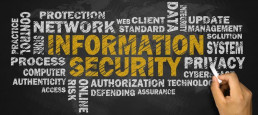
Create an Effective Security Risk Management Program
Defeating cybercriminals and halting internal threats is a challenging process. Bringing data integrity and availability to your enterprise risk management is essential to your employees, customers, and shareholders.
Creating your risk management process and take strategic steps to make data security a fundamental part of conducting business.
In summary, best practices include:
- Implement technology solutions to detect and eradicate threats before data is compromised.
- Establish a security office with accountability.
- Ensure compliance with security policies.
- Make data analysis a collaborative effort between IT and business stakeholders.
- Ensure alerts and reporting are meaningful and effectively routed.
Conducting a complete IT security assessment and managing enterprise risk is essential to identify vulnerability issues.
Develop a comprehensive approach to information security.
PhoenixNAP incorporates infrastructure and software solutions to provide our customers with reliable, essential information technology services:
- High-performance, scalable Cloud services
- Dedicated servers and redundant systems
- Complete software solutions for ISRM
- Disaster recovery services including backup and restore functions
Security is our core focus, providing control and protection of your network and critical data.
Contact our professionals today to discuss how our services can be tailored to provide your company with a global security solution.
Recent Posts
Definitive Guide For Preventing and Detecting Ransomware
In this article you will learn:
- Best practices to implement immediately to protect your organization from ransomware.
- Why you should be using threat detection to protect your data from hackers.
- What to do if you become a ransomware victim. Should you pay the ransom? You may be surprised by what the data says.
- Where you should be backing up your data. Hint, the answer is more than one location.
- Preventing ransomware starts with employee awareness.
Ransomware has become a lucrative tactic for cybercriminals.
No business is immune from the threat of ransomware.
When your systems come under ransomware attack, it can be a frightening and challenging situation to manage. Once malware infects a machine, it attacks specific files—or even your entire hard drive and locks you out of your own data.
Ransomware is on the rise with an increase of nearly 750 percent in the last year.
Cybercrime realted damages are expected to hit $6 trillion by 2021.
The best way to stop ransomware is to be proactive by preventing attacks from happening in the first place. In this article, we will discuss how to prevent and avoid ransomware.
What is Ransomware? How Does it Work?
All forms of ransomware share a common goal. To lock your hard drive or encrypt your files and demand money to access your data.
Ransomware is one of many types of malware or malicious software that uses encryption to hold your data for ransom.
It is a form of malware that often targets both human and technical weaknesses by attempting to deny an organization the availability of its most sensitive data and/or systems.
These attacks on cybersecurity can range from malware locking system to full encryption of files and resources until a ransom is paid.
A bad actor uses a phishing attack or other form of hacking to gain entry into a computer system. One way ransomware gets on your computer is in the form of email attachments that you accidentally download. Once infected with ransomware, the virus encrypts your files and prevents access.
The hacker then makes it clear that the information is stolen and offers to give that information back if the victim pays a ransom.
Victims are often asked to pay the ransom in the form of Bitcoins. If the ransom is paid, the cybercriminals may unlock the data or send a key to for the encrypted files. Or, they may not unlock anything after payment, as we discuss later.
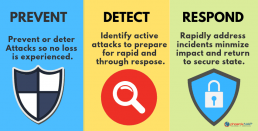
How To Avoid & Prevent Ransomware
Ransomware is particularly insidious. Although ransomware often travels through email, it has also been known to take advantage of backdoors or vulnerabilities.
Here are some ways you can avoid falling victim and be locked out of your own data.
1. Backup Your Systems, Locally & In The Cloud
The first step to take is to always backup your system. Locally, and offsite.
This is essential. First, it will keep your information backed up in a safe area that hackers cannot easily access. Secondly, it will make it easier for you to wipe your old system and repair it with backup files in case of an attack.
Failure to back up your system can cause irreparable damage.
Use a cloud backup solution to protect your data. By protecting your data in the cloud, you keep it safe from infection by ransomware. Cloud backups introduce redundancy and add an extra layer of protection.
Have multiple backups just in case the last back up got overwritten with encrypted ransomware files.
2. Segment Network Access
Limit the data an attacker can access with network segmentation security. With dynamic control access, you help ensure that your entire network security is not compromised in a single attack. Segregate your network into distinct zones, each requiring different credentials.
3. Early Threat Detection Systems
You can install ransomware protection software that will help identify potential attacks. Early unified threat management programs can find intrusions as they happen and prevent them. These programs often offer gateway antivirus software as well.
Use a traditional firewall that will block unauthorized access to your computer or network. Couple this with a program that filters web content specifically focused on sites that may introduce malware. Also, use email security best practices and spam filtering to keep unwanted attachments from your email inbox.
Windows offers a function called Group Policy that allows you to define how a group of users can use your system. It can block the execution of files from your local folders. Such folders include temporary folders and the download folder. This stops attacks that begin by placing malware in a local folder that then opens and infects the computer system.
Make sure to download and install any software updates or patches for systems you use. These updates improve how well your computers work, and they also repair vulnerable spots in security. This can help you keep out attackers who might want to exploit software vulnerabilities.
You can even use software designed to detect attacks after they have begun so the user can take measures to stop it. This can include removing the computer from the network, initiating a scan, and notifying the IT department.
4. Install Anti Malware / Ransomware Software
Don’t assume you have the latest antivirus to protect against ransomware. Your security software should consist of antivirus, anti-malware, and anti-ransomware protection.
It is also crucial to regularly update your virus definitions.
5. Run Frequent Scheduled Security Scans
All the security software on your system does no good if you aren’t running scans on your computers and mobile devices regularly.
These scans are your second layer of defense in the security software. They detect threats that your real-time checker may not be able to find.

6. Create Restore & Recovery Points
If using windows, go to the control panel and enter in System Restore into the search function. Once you’re in System Restore, you can turn on system protection and create regular restore points. You should also create restore points.
In the event you are locked out, you may be able to use a restore point to recover your system.
7. Train Your Employees and Educate Yourself
Often, a ransomware attack can be traced back to poor employee cybersecurity practices.
Companies and individuals often fall victim to ransomware because of a lack of training and education.
Ransomware preys on a user’s inattentiveness, expecting an anti ransomware program to do their jobs for them. Nothing protects a system like human vigilance.
Employees should recognize the signs of a phishing attack. Keep yourself and your employees up-to-date on the latest cyber attacks and ransomware. Make sure they know not to click on executable files or unknown links.
Regular employee security awareness training will remind your staff of their roles in preventing ransomware attacks from getting through to your systems.
Stress the importance of examining links and attachments to make sure they are from a reliable source. Warn staff about the dangers of giving out company or personal information in response to an email, letter, or phone call.
For employees who work remotely, make it clear that they should never use public Wi-Fi because hackers can easily break in through this kind of connection.
Also, make it clear that anyone reporting suspicious activity does not have to be sure a problem exists. Waiting until an attack is happening can mean responding too late. Have an open door and encourage employees to express concerns.
8. Enforce Strong Password Security
Utilize a password management strategy that incorporates an enterprise password manager and best practices of password security.
According to background check service Instant Checkmate, 3 out of 4 people use the same password for multiple sites . More staggering is that one-third use a significantly weak password (like abc1234 or 123456. Use multiple strong passwords, especially for sensitive information.
9. Think Before Clicking
If you receive an email with the attachments .exe, .vbs, or .scr, even from a “trusted” source, don’t open.
These are executable files that are most likely not from the source you think it’s from. Chances are the executables are ransomware or a virus. Likewise, be especially vigilant with links supposedly sent by “friends,” who may have their addresses spoofed. When sent a link, be sure the sending is someone you know and trust before clicking on it. Otherwise, it may be a link to a webpage that may download ransomware onto your machine.
10. Set Up Viewable File Extensions
Windows allows you to set up your computers to show the file extensions when you look at a file. The file extension is the dot followed by three or four letters, indicating the type of file.
So, .pdf is a PDF file, .docx is a Window’s Word document, etc. This will allow you to see if the file is an executable, such as a .exe, vbs, or .scr. This will reduce the chance of accidentally opening a dangerous file and executing ransomware.

11. Block Unknown Email Addresses and Attachments On Your Mail Server
Start filtering out and rejecting incoming mail with executable attachments. Also, set up your mail server to reject addresses of known spammers and malware. Icann has listings of free or low-cost services which can help you do that.
If you don’t have a mail server in-house, be sure that your security services can at least filter incoming mail.
12. Add Virus Control At The Email Server Level
Most attacks start with a suspicious email that a victim is fooled into opening. After opening it or clicking on a link, the virus is unleashed and can do its dirty work.
Installing anti-virus and malware software on your email server can act as a safeguard.
13. Apply Software and OS patches ASAP
Malware often takes advantage of security loopholes and bugs within operating systems or software. This is why it is essential to install the latest updates and patches on your computers and mobile devices.
Staying with archaic versions is a guaranteed way of making your systems and their data a target. For example, the ransomware worm, WannaCry, took advantage of a security breach in older versions of Windows, making computers that had not been patched vulnerable. WannaCry spread through the Internet, infecting computers without a patch — and without user interaction. Had the companies that were attacked by WannaCry kept their computer operating systems up to date, there would’ve been no outbreak. A costly lesson for users and companies.
14. Block Vulnerable Plug-Ins
There are many types of web plug-ins that hackers use to infect your computers. Two of the most common are Java and Flash. These programs are standard on a lot of sites and may be easy to attack. As a result, it is important to update them regularly to ensure they don’t get infected by viruses.
You may even want to go the extra step of completely blocking these programs.
15. Limit Internet Connectivity
If you have genuinely critical data, your next step may be keeping your network private and away from the Internet entirely.
After all, if you don’t bring anything into your network, your computers are unlikely to have ransomware downloaded to them. This may be impractical seeing that many companies rely on the Internet and email to do their business, but keeping Internet access away from critical servers may be a way to combat ransomware and viruses.
How to Detect Ransomware
Unfortunately, if you have failed to avoid ransomware, your first sign might be an encrypted or locked drive and a ransom note.
If you run your malware and virus checker frequently with updated virus and malware definitions, your security software may detect the ransomware and alert you to its presence. You can then opt to quarantine and delete the ransomware.

What to Do If Your Computer Is Infected With Ransomware
Hopefully, you never have to deal with your data being held hostage.
Minimize damage by immediately isolating the machine — this critical to prevent further access to your network.
At this stage, rebuild your system and download your backups.
You may be able to recover many resources with a system restore. That is if you can access the system and are not locked out of it.
Otherwise, you’ll have to reinstall everything from backups. If you’ve backed up your crucial data on a cloud server, you should be able to find a safe restore point.
Should You Pay the Ransom?
You may be tempted to pay the ransomers to get your data back.
This is a terrible idea.
According to a Symantec ransomware report, only 47% of people who pay the ransom get their files back.
Every time someone pays the ransom, criminals gain more confidence and will likely keep hurting businesses.
Not only will you encourage them to continue, but you have no idea if they will free your computer. What’s more, even if they release your data, they may still use your information.
In other words, don’t pay. You’re stuck with making a bad situation even worse by paying the ransom. The data is gone (unless you have backups) and, if you pay them, your money is likely gone for good as well.
To quote FBI Cyber Division Assistant Director James Trainor:
“The FBI does not advocate paying a ransom to an adversary. Paying a ransom does not guarantee that an organization will regain access to their data. In fact, some individuals or organizations were never provided with decryption keys after paying a ransom. Paying emboldens the adversary to target other organizations for profit and offers a lucrative environment for other criminals to become involved.”
Finally, by paying a ransom, an organization is funding illicit activity associated with criminal groups, including potential terrorist groups, who likely will continue to target an organization.

Have a Disaster Recovery Plan
Proactive ransomware detection includes active incident response, business continuity, and a plan for disaster recovery.
A plan is essential and should be the cornerstone of a company’s security strategy.
- Set up a communication plan detailing who should contact who.
- Determine what equipment you would need to rent or buy to keep operations going. Plan for your current hardware to be unavailable for days.
- Write explicit instructions on where data is stored and how to retrieve it.
- Implement a policy of backing up regularly to prevent ransomware from causing data loss.
- Implement a disaster recovery service.
- Provide phone numbers for contacting vendors who may be able to restore the systems they provide for you.
Prevent a Ransomware Attack With Preparation
Companies must remain vigilant in today’s era of data breaches and ransomware attacks.
Learn the proper steps to prevent, detect and recover from ransomware, and you can minimize its impact on your business. Use these tips to keep your organization’s information assets safe and stop a ransomware attack before it starts.
Use a trusted data center provider and vendors. Perform due diligence to make sure they are trustworthy.
Recent Posts
11 Steps To Defend Against the Top Cybersecurity Threats in Healthcare
Imagine your patient data being held hostage by hackers. Security threats in healthcare are a genuine concern.
The U.K.’s healthcare industry recently suffered one of the largest cyber breaches ever.
WannaCry, a fast-moving global ransomware attack shut the NHS systems down for several hours. Healthcare institutions all over the country were unable to access patient records or schedule procedures. Appointments were postponed, and operations got canceled while experts worked to resolve the issue.
Although the attack impacted other companies and industries as well, the poorly defended healthcare system took a more significant hit. It was just one of the incidents that showed the extent to which healthcare institutions are vulnerable to cyber threats. Learn how to be prepared against the latest cybersecurity threats in healthcare.

11 Tips To Prevent Cyber Attacks & Security Breaches in Healthcare
1. Consider threat entry points
An entry point is a generic term for a vulnerability in your system that can be easily penetrated by hackers. By exploiting this vulnerability, hackers can deploy a virus to slow your network, access critical health information, or remove defenses to make your system more accessible in the future.
Malware can be introduced from any vulnerable spot in your network or operating system.
An employee can unknowingly click a file, download unauthorized software, or load a contaminated thumb drive. Also, when strong secure passwords are not used, an easy entry point for hackers is created.
Moreover, medical software and web applications used for storing patient data were found to contain numerous vulnerabilities. Healthcare cybersecurity statistics by Kaspersky Security Bulletin found open access to about 1500 devices that healthcare professionals use to process patient images.
2. Learn about ransomware attacks
A ransomware attack is a specific type of malware which threatens to lock one computer or an entire network unless a certain amount of money is paid.
The ransom is not necessarily an impossibly high figure either. Even demanding a few hundred dollars from a business could still be easy money for a hacker, and more manageable for individuals or companies to come up with to get their computers back.
3. Create a ransomware policy
One disabled computer does not necessarily bring much damage. However, the risk of not being able to access larger sectors where electronic records reside could be disruptive, even dangerous to patient treatment.
When such an incident happens, employees must immediately contact someone on their healthcare IT team. This should be part of their security training and overall security awareness. They must follow healthcare organization procedures when they see a ransomware message, instead of trying to resolve the matter themselves.
Authorities warn against paying ransomware culprits since there’s no guarantee a key will be given. Criminals may also re-target companies that paid them in the past.
Many companies solve ransomware attacks by calling the police and then wiping the affected computer and restoring it to a previous state.
Cloud data backups can make it easy to restore systems in the events of an attack. Disaster recovery planning should be done before a cyber security threat occurs.

Employee Roles in Security in Healthcare
4. Focus on Employee Security training
Cybersecurity professionals employ robust firewalls and other defenses, but the human factor remains a weak link as was displayed in the WannaCry exploit.
To minimize human error, system admins need to remind all staff about risky behavior continually. This can include anything from downloading unauthorized software and creating weak passwords to visiting malicious websites or using infected devices.
Educate employees on how to recognize legitimate and suspicious emails, threats, and sites so they can avoid phishing attacks. (Unusual colors in logos or different vocabulary are both warning signs). Training should be refreshed regularly or customized for different employee groups.
5. Create or expand security Measure risk levels
Different employee groups should be provided with varying privileges of network access.
At a hospital, nurses may need to share info with other staff in their unit, but there’s no reason for other departments to see this. Visiting doctors may receive access to only their patient’s info. Security settings should monitor for unauthorized access or access attempts at every level.
Chris Leffel from Digital Guardian suggests training/education first, followed by restricting specific apps, areas and patient healthcare data. He also recommends requiring multi-factor authentication, which is an additional layer of protection.
6. Healthcare Industry Cybersecurity Should Go beyond employee access
Patient concerns about sensitive data security and IT in healthcare should be kept in mind when creating safer, stronger systems, or improving cybersecurity frameworks after a hospital was hacked.
Patients are often already nervous and don’t want to worry about data security. Likewise, system administrators should also make sure that threat intelligence funding remains a priority, which means continuing to invest in security initiatives.
Publicizing you have taken extra steps in your patient security efforts will drive more security-conscious patients your way. Patients care.

7. Protect Health Data on ‘smart’ equipment
Desktops, laptops, mobile phones, and all medical devices, especially those connected to networks, should be monitored and have anti-virus protection, firewalls, or related defenses.
Today’s medical centers also possess other connected electronic equipment such as medical devices like IV pumps or insulin monitors that remotely sync patient information directly to a doctor’s tablet or a nurse’s station. Many of these interconnected devices could potentially be hacked, disrupted, or disabled, which could dramatically impact patient care.
8. Consider cloud migration For Your Data
The cloud offers a secure and flexible solution for healthcare data storage and backup. It also provides a possibility to scale resources on-demand, which can bring significant improvements in the way healthcare organizations manage their data.
Cloud-based backup and disaster recovery solutions ensure that patient records remain available even in case of a breach or downtime. Combined with the option to control access to data, these solutions can provide the needed level of security.
With the cloud, a healthcare organization does not have to invest a lot in critical infrastructure for data storage. HIPAA Compliant Cloud Storage allows for significant IT cost cuts, as no hardware investments are needed. It also brings about a new level of flexibility as an institution’s data storage needs change.
9. Ensure vendors Are Compliant
The Healthcare Industry Cybersecurity Task Force, established by the U.S. Department of Health and Human Services and Department of Homeland Security, warned providers of areas of vulnerability in the supply chain. One of their requirements is for vendors to take proper steps to monitor and detect threats, as well as to limit access to their systems.
Insurance companies, infrastructure providers, and any other healthcare business partners must have spotless security records to be able to protect medical information. This is especially important for organizations that outsource IT personnel from third-party vendors.
10. How HIPAA Compliance can help
Larger healthcare organizations have at least one person dedicated to ensuring HIPAA compliance. Their primary role is creating and enforcing security protocols, as well as developing a comprehensive privacy policy that follows HIPAA recommendations.
Educating employees on HIPAA regulations can contribute to creating a security culture. It also helps to assemble specific HIPAA teams, which can also share suggestions on how to restrict healthcare data or further cyber defenses in the organization.
HIPAA compliance is an essential standard to follow when handling healthcare data or working with healthcare institutions. Its impact on the overall improvement of medical data safety is significant, and this is why everyone in healthcare should be aware of it.
11. Push a top-down Security Program
Every medical facility likely has a security staff and an IT team, but they rarely overlap. Adding healthcare cybersecurity duties at a managerial level, even as an executive position, can bring multiple benefits.
It can make sure correct initiatives are created, launched, and enforced, as well as that funding for security initiatives is available. With cybersecurity threats, being proactive is the key to ensuring safety long term. Regular risk assessments should be part of any healthcare provider’s threat management program.
Healthcare: $3.62 Million Per Breach
Cybersecurity in the healthcare industry is under attack. Cybersecurity threats keep hospital IT teams up at night, especially since attacks on medical providers are expected to increase in 2018.
The latest trends in cybersecurity might be related to the fact that healthcare institutions are moving towards easier sharing of electronic records. That and a potentially nice payoff for patient information or financial records make healthcare a hot target for hackers.
For medical centers themselves, hacks can be costly. The average data breach costs a company $3.62 Million. This includes stolen funds, days spent investigating and repairing, as well as paying any fines or ransoms. Attacks can also result in a loss of records and patient information, let alone long-lasting damage to the institution’s reputation.
As much as hospitals and medical centers try to protect patient privacy, security vulnerabilities come from all sides. A great way to keep up with the latest security threats is to attend a data security conference.
Healthcare organizations want to send patient info to colleagues for quick consultations. Technicians pull and store sensitive data easily from electronic equipment. Patients email or text their doctor directly without going through receptionists, while admins often send a patient record to insurance companies or pharmacies.
So the industry finds itself in a dangerous position of trying to use more digital tools to improve the patient experience while following a legal requirement to safeguard privacy. No wonder IT teams continuously wonder which hospital will be hacked next.
The truth is that healthcare institutions are under a significant threat. Those looking to improve security should start with the steps outlined below.
In Closing, The Healthcare Industry Will Continue to Be Vulnerable
Healthcare facilities are often poorly equipped to defend their network activities and medical records security. However, being proactive and aware of ever-changing cybersecurity risks can help change the setting for the better.
Of course, education alone won’t help much without battle-ready infrastructure. With the assistance of healthcare industry cybersecurity experts like phoenixNAP, your healthcare organization can ensure security on multiple levels.
From backup and disaster recovery solutions to assistance creating or expanding a secure presence, our service portfolio is built for maximum security.
Do not let a disaster like WannaCry happen to your company. Start building your risk management program today.
We have created a free HIPPA Compliance Checklist.
Recent Posts
27 Terrifying Ransomware Statistics & Facts You Need To Read
Ransomware is a form of malware or a virus that prevents users from accessing their systems or data until a sum of money is paid.
Clicking on infected links is still a primary way for cybercriminals to deliver their payloads. Ransomware was the most significant malware threat of 2018, with numerous high profile ransomware attacks. These malicious attacks show no signs of slowing in 2019.
Only with a proactive disaster recovery plan can increase your chances of withstanding a ransomware attack.
Let’s look at the staggering facts.
50% of a surveyed 582 cybersecurity professionals do not believe their organization is prepared to repel a ransomware attack. (Source: Pwnie Express)
Ransomware costs businesses more than $75 billion per year. (Source: Datto)
The average cost of a ransomware attack on businesses was $133,000. (Source: Sophos)
75% of companies infected with ransomware were running up-to-date endpoint protection. (Source: Sophos)
Want to learn the key tactics to preventing and detecting ransomware attacks? Read This.
Rate Of Ransomware Attacks
- A new organization will fall victim to ransomware every 14 seconds in 2019, and every 11 seconds by 2021. (Source: Cyber Security Ventures)
- 1.5 million new phishing sites are created every month. (Source: webroot.com)
- Ransomware attacks have increased over 97 percent in the past two years. (Source: Phishme)
- A total of 850.97 million ransomware infections were detected by the institute in 2018.
- 34% of businesses hit with malware took a week or more to regain access to their data. (Source: Kaspersky)
- In 2019 ransomware from phishing emails increased 109 percent over 2017. (Source: PhishMe)

Statistics on Ransom Demands
Ransomware financial demands are often severe and significant.
Ransomware Statistics show that hackers are focusing more steadily on large businesses who will often pay tens of thousands of dollars to receive their data back.
- An IBM study suggested that over a quarter of all companies would pay more than $20,000 to hackers to retrieve data that had been stolen.
- Ransomware generates over $25 million in revenue for hackers each year. (Source: Business Insider)
- The NotPetya ransomware attack cost FedEx $300 million in Q1 2017. (Source: Reuters)
- More than half of ransoms were paid bitcoin.
- The average ransom demand increased in 2018 to $1,077.
- Ten percent of all ransom demands are over $5,000. (Source: Datto)
- Fewer than a third of organizations who pay the ransom receive all of their money back. (Source: Courant
- 97% of United States’ companies refused to pay a ransom. 75% of Canadian companies paid, followed by, 22% of German businesses, and 58% in the UK.

Facts on The Biggest Ransomware Attacks of 2018
Recent ransomware attacks in 2018 crippled businesses large and small. Here is an insight into just a few high profile cases.
TSMC
A new variant of WannaCry ransomware wreaked havoc with Taiwan Semiconductor Manufacturing Company (TSMC) this summer.
The manufacturer was forced to shut down several of its chip-fabrication factories in August temporarily. This was after the virus spread to 10,000 machines in TSMC’s most secure and advanced facilities.
Under Armour
Fitness brand Under Armour was also dealt a black eye by ransomware. Their app “MY Fitness Pal”- a portal through which users could track their diet and fitness was breached by malware.
The brand insists that the data did not contain sensitive data like social security numbers and drivers license numbers (which the app does not collect). Nor were customer payment details affected. This breach affected 150 million users.
The City of Atlanta
In March this year, the alleged creators of the SamSam ransomware launched an attack on the infrastructure of the city of Atlanta GA. The attack affected many of the city’s essential municipal functions. Among those affected were citizens’ ability to pay water bills or parking tickets.
- The ransomware demand was $51,000 (unpaid) while the recovery costs were estimated at $17 million.
- Local government in Atlanta spent over $5 million to rebuild their infrastructure after a SamSam ransomware attack in March 2018.
Industries under attack
The Healthcare Industry
The healthcare industry has historically been low hanging fruit for malware. 2018 was no exception.
- Almost half of the ransomware incidents reported in 2018 involved healthcare companies. (Source: Beazley)
- 90% of healthcare organizations saw an increase in ransomware infection rates from 2017 to 2018. (Ponemon Institutes)
- 18% of healthcare devices have been the target of malware. (Source: Healthcare IT News)
- A report by CSO online estimates healthcare related malware attacks will likely quadruple by 2020.
Financial Institutions
90% of all financial institutions have experienced ransomware in the past year. (betanews.com)
These businesses have a virtual treasure trove of bank account numbers, routing numbers, and Social Security numbers that hackers can steal and later sell on the dark web.
In Q1 of 2019, Kaspersky Labs reported:
- More than 204,448 users experienced an attempt to log their banking information
- More than 280,000,000 URLs were identified as malicious
- Cybersecurity statistics show attacks were launched from within more than 190 countries
- Attacks on individuals doubled in 2018.
- Attacks on Businesses increased to one every 40 seconds.
Mobile Ransomware Threats Grow
The frightening rise of mobile malware is staggering. You may not realize that their handheld electronics are the next battlefield for domination of their personal information. In an increasingly mobile work environment, all businesses and their employees must be extra vigilant.
- Mobile malware, banking malware, and ransomware are the primary threats to expect in 2019. (Source: Fortinet)
- More than 18 million mobile malware instances were detected by Symantec in 2018. (source: Symantec)
- In Q1 2018 alone, Kaspersky Labs detected over 8,000 mobile banking ransomware Trojan installations.
- Kaspersky Labs found that the majority of the malware in 2018 was targeting phones on the Android operating system.
- Cybersecurity giant Symantec identified mobile use as a significant point of vulnerability for businesses and private users in 2018. In their annual Internet Security Threat Report (ISTR) they state “Threats in the mobile space continue to grow year-over-year, including the number of new mobile malware variants which increased by 54 %”.
- Less than 20% of mobile malware is delivered via a browser — the remainder of the payloads come through an app. (Source: RSA Current State of Cybercrime)
2019 Global Ransomware Predictions, By The Numbers
What are experts predicting for 2019 and beyond?
- 81 % of cybersecurity experts believe there will be a record number of ransomware attacks in 2019. (Source: CIO Dive)
- McAfee analysts suggest that individuals with a large number of connected devices and a high net worth are some of the most attractive targets.
- Attacks against Linux and Macs are expected to rise, according to IT Security Guru.
- The average costs of data breaches will reach into the hundreds of millions of dollars by 2020. (Source: Juniper Research)
- Recent studies have shown that ransomware attacks are increasing more than 300% year over year. (dimensiondata.com)
- Cybercriminals will target SaaS (Software as a Service) and cloud computing businesses, which store and secure private data. (Source: Massachusetts Institute of Technology)
- The cybersecurity research body suggests that ransomware damage costs will rise to $11.5 billion in 2019.
- Mobile malware, banking malware, and ransomware are the primary threats to expect in 2019 according to Fortinet.
- The Internet of Things (IoT) is primed to revolutionize life for businesses and consumers alike. However, the inherent vulnerability of this nascent technology can leave it wide open to ransomware attacks. A report by Kaspersky Lab indicated that new malware targeting IoT enabled devices grew threefold in 2018. Since 2017, the number of IoT focused malware attacks rose 10x from 2016.
Final Thoughts On Ransomware Statistics
As cybercriminals continue to see the value in encrypting data and restricting the access of users, ransomware will continue to grow.
While newer cyber threats increase, these final stats quickly show that ransomware isn’t going away anytime soon.
50% of companies report that they do not feel as though they are adequately prepared for the threat. (healthitsecurity.com)
With damage related to cybercrime set to hit $6 trillion by 2021, investing in security spending should be a priority for 2019.
Recent Posts
What is Privileged Access Management? Why It Should Be a Security Priority
According to the latest report from Gartner, Privileged Access Management is the number one cyber security priority for CISO’s.
The question for IT professionals is how to provide secure management for accessing data.
In this article, learn what privileged access management is and how to manage security risks by implementing PAM.
What Is Privileged Access Management? A Definition
Privileged Access management enforces least privilege policies. It also empowers organizations to reduce the threat of security attacks & data breaches.
Privileged Access Management is also often referred to as “Privileged Session Management” or “Privileged Account Management.”
Privileged security provides the power to protect your data and IT systems.
PAM acts as a secure repository, or vault, that protects your data and networks. With privileged user management, users only access the data required for their work. IT teams set these parameters. It prevents users from accessing other systems and information.
For example, a business might have one or two employees with administrator access to a Microsoft Exchange Server. Setting up email security protocols is achieved through administrator access. Only those users can delete an email account or set up a new one.
A business could assign another employee unauthorized access to company financials. Another employee might have a role in installing software.
With privileged management guidelines, you reduce organizational security risks.

What is a Privileged Account?
Privileged account and access management restricts access to privileged users.
It manages administrator access while logging and monitoring all activity.
Manage and Control Access Privileges
Using an Access Manager or Dashboard within the PAM system, a user can manage and control privileges.
It is the central location to set account-level privileges. It provides a user with real-time control over system access.
An organization can manage access for each user. A user can control the information they receive.
With access control, user restrictions can be set to allow for adding, modifying, or even deleting data. In most cases, a system has it’s own level of privileged management, assigning access to users with specific access. Groups of users with similar privileges and access needs are created and assigned a particular group, often known as administrators.
Use Privileged Management To Monitor Administrator Access
PAM security gives organizations additional control over the administrators and privileged users. These are the users with access that increases the risk to the business. They don’t directly access your data and systems.
Instead, they first access the privilege manager dashboard.
The log-in information of a user with admin access is stored inside the PAM system. It is kept within a structure known as a Shared Access Password Manager (SAPM). A SAPM will isolate and protect admin account passwords. Added security protocols can then be assigned to these passwords.
Once inside, the admin user will access their credentials. The system then authenticates the users. Access is always monitored and recorded.
This is another layer of protection for the business.
Additional Protection With Privileged Session Management
Other protocols can be used to manage administrator privileges within a network. Privileged session management protects against suspicious users.
With PSMs, admin sessions are actively monitored by a superuser. A superuser can stop a session immediately if a problem occurs. If there is a concern that the system may be compromised, multiple levels of threat detection will alert for a rapid response to resolving the issue.
When an administrator has finished work, credentials are logged, and the credential system is reset within the PAM system. This provides another layer of securing your data and network ensuring sessions aren’t left open. It removes a potential vulnerability for attackers. No one can gain entry to the system without being authenticated first.
An enterprise password manager or password vault is another way to store credentials.
It provides a direct application-to-application connection. Instead of the user, the Application-to-Application Password Manager (AAPM) logs into the app. No user requires direct access to the software. Users may not even have access to a password as they often don’t need them.

The Benefits of Privileged Access Security
Many companies are concerned about data security. Cybercrime last year cost businesses more than $600 billion.
In the past, organizations have had limited success in increasing cybersecurity. To be successful in preventing cyber attacks, a company needs to have a central strategy to protect critical systems. They need real-time network control. They need to secure access to data without creating vulnerabilities.
Privileged Account Management can help.
PAM security provides a single-management solution to many cybersecurity needs. It protects critical systems. It limits access to your data. It gives you a highly-secure solution for storing and accessing credentials. It provides security without frustrating employees.
Businesses use PAM to reduce the risk of a data breach. It increases security, and limits access to core systems.
Companies see other benefits:
- Streamlined Access: Manage and control access to the network. Don’t use a piecemeal solution that leaves holes in your security. Stop adding IT workarounds when something doesn’t work. Create access protocols. You can then enforce the protocols with the same solution. PAM Solutions allows for the management of your entire network with a single platform.
- Real-time Monitoring and Control: Grant access to data and systems when and where they are needed. Remove access just as quickly when the need is required. It’s easy to add and remove privileges and users, but it is much more difficult once a threat is detected. Monitor activity in real-time. Quickly remove access at first sight of suspicious activity. Take control of critical systems.
- Create an Access Record: As you monitor accounts, you create an audit trail of activity. You can review how and when users accessed the system. Review the audit logs for problems. Don’t be the last to know when issues happen. Stay ahead of the game.
Many highly-regulated industries that deal with sensitive data rely on PAM. Financial records or protected customer information can better be secured using privileged accounts. Patient records and health information are protected by access management. Many healthcare providers use PAM as part of their HIPPA Compliance plan.

Reduce Risk with Privileged Account Best Practices
Privileged credentials limit access and also monitor your systems and network. The system creates a record of each privileged user and provides a history of administrator activity. You know who and when data was accessed.
This allows you to monitor suspicious activity. You’ll know when there is a potential cyber security threat.
Don’t think of PAM as a punishment for employees; it keeps employees and your data safe.
It also helps prevent misuse of administrative access. By limiting user privileges, there are fewer avenues for criminals. Exploiting user access to a system has led to many of the worst cybersecurity data breaches over the last year.
Limiting privileges reduces the risk an attacker will steal admin credentials. With credentials, the attacker can change security protocols. They can take data, install viruses, and even hide, so you don’t know they attacked. PAM security helps prevent these attacks.
The Differences Between PAM Systems and Privileged Identity Management
Privileged Account Management and Privileged Identity Management (PIM) are similar. There are also significant differences between them.
PAM manages privileged user access. It allows exclusive access to core data and systems. The PAM will block and isolate users in the network. They can only access the areas they have the privilege to use.
PIM, or Identity management (IdM), focuses on authorized users. PIM creates an identity for a user in the system. Users authenticate the identity before access is granted. Think of it as the door into your network. It opens the network but provides limited control over privileges inside. Most of the control is on authenticating the identity.
Within that identity, you can set privileges. You can limit access during the creation of the identity. This is the connection between PAM and PIM. The focus of PIM is opening the systems, and not restricting them. It doesn’t monitor access; it adds more protection by creating layers of security for core systems and data. The focus is on protection and reducing risk, especially for critical root access.
Take Privileged Account Management to the Next Level
The first step in your security process is at the very least started: understanding your organization needs a process.
As a beginning stage, start by reviewing how you currently manage user access. Many companies are surprised to find many users have unlimited levels of access.
With an open network, users can access unnecessary data or have system privileges outside the scope of their job needs.
Begin tracking administrator access with a privilege management program. You may find habits and behaviors are also increasing risk.
Start to focus on what employees require on a permission scale and establish a hierarchy system for monitoring and access. This system will be particularly relevant as your organization grows. The larger your company becomes, the more privileges users you will have. Some companies have 2-3x as many privileged users as employees due to factors such as remote contractors, automated users, etc.
Next, reach out to data security experts. Have them review your current practices. The expertise and experience they bring to project are critical. This insight can provide additional server security without sacrificing efficiency.
By centralizing credentials, Privileged Access Management will improve your security.
Remember that PAM is only one stage in the full-scale spectrum of security management.
Recent Posts
Bare Metal Backup, Restore, & Recovery: 7 Things IT Pros Need To Know
Many technology professional initially think of bare metal recovery as a tool for emergencies only.
A disaster that impacts your network can take any number of forms. A flood, storm or fire could wipe out your data center or systems; hackers could hold your network for ransom or a malicious insider could let cybercriminals in. In the end, it does not matter if you had a careless employee or faced the wrath of Mother Nature — the result is a catastrophic failure of your network and the total interruption of your organization’s ability to do business.
A backup recovery strategy is paramount. Most incidents allow for recovery.
Simple turn things over to an IT team or even a virtual program and wait for the restoration of your systems. But for those cases where you are unaware of the extent of damage or that destroy your systems beyond repair, bare metal disaster recovery may be needed.

What is Bare Metal Backup?
With traditional bare metal recovery methods, you move information from one physical machine to another.
Enterprise systems allow you to try a variety of bare metal backup combinations.
This can include moving a physical machine to a virtual server; a virtual server to a physical machine; or a virtual machine to another virtual server.
Some methods require converting your original system’s physical image into a virtual image. Utility tools for this include dd in Linux; ddr in IBM VM//370; WBadmin in Windows Server 2008; and Recovery Environment in Windows.
You can also use your original machine information to create multiple identical virtual or physical machines.
These can be useful if you’ve made an optimal machine or a server configuration you like. Backups of your original machine can be handy if you ever need more versions. For instance, you may want to increase space in a server volume.
Your virtual servers will be able to come online quickly from the backup. This is a better option than taking a long time to create something new from scratch each time.
Likewise, if one of your virtual servers appears to be crashing, you can make a quick identical copy.
What is Bare Metal Restore or Recovery?
Bare metal recovery or bare metal restoration is a type of disaster recovery planning for your network.
This is used after a catastrophic failure, breach or emergency; the “bare metal” part of the term refers to starting almost from scratch. When an IT expert performs this task, they are working from the very beginning and recovering, reinstalling and rebuilding your system from the ground (or bare metal) up.
This approach means starting with clean, working hardware and reinstalling operating systems and other software; this way you know your network is being restored on a new, error-free base without any lingering risk or problems.
Begin bare metal restore by saving an image of your existing machine or server onto an ISO file or placing it onto a thumb drive or a network server. Then load the image or file onto your ‘blank’ machine.
The term ‘bare metal’ describes how the second machine contains just a hard drive, a motherboard, processor and a few drivers.
If you perform the formatting correctly, you’ll be able to bring back your settings and data quickly. This can be done in a few hours, faster than a full rebuild. Re-installing all applications and drivers could take days.
A lot could go wrong if recovery takes place incorrectly. If the motherboards, processors or BIOS differ even slightly, the new machine may not boot. Data loss, corrupt or general data failure all could take place.
Newer tools improve the odds of data being adequately restored. Individual drivers can modify system settings on the second machine’s CPU. This can make sure an adequate boot-up occurs even if the hardware is different.
Bare metal restore is recommended as a smart disaster recovery method. Loading data onto a new machine takes place quickly. This can be useful for critical situations such as hardware failure or cyber attacks.
While this is a restore of last resort (no one wants to have to do it), it does provide you with peace of mind about the process and your network’s integrity.
If your disaster was a breach, managing security risk is an essential part of recovery resume your normal functions with confidence.

Benefits of Bare Metal Restoration
Bare metal restoration can be useful for emergencies, virtual environments and hybrid cloud/dedicated systems.
At the same time, a BMR shouldn’t be thought of as a continuous server backup.
Most standard system backup tools allow users to designate which items should be saved. This often includes documents, folders and application data, not the applications themselves. Creating a full backup also may allow you to choose when and how often it takes place.
Another type of backup is a system state, which allows you to recover your operating system files even with a lost registry.
A restoration, on the other hand, copies over an entire drive, including applications. It can be compared to a one-time snapshot of your machine or server at a specific time.
Bare metal restoration is similar to Windows System Restore. This tool restarts your system from a previous save point. A BMR does the same task but does so from within a different machine.
A bare metal restoration can also include a system state backup and disaster recovery.
Data Backup vs. Data Recovery
Bare metal recovery can go beyond emergencies or multiple virtual machines. It can also enhance cloud architecture, improve security and conserve resources. Another use has been found for bare metal recovery. It can be a way to create multiple copies along with backups of virtual machines easily.
You can also create a bare metal dedicated server. This can be useful for companies that use cloud services but have traffic spikes during peak times. For instance, a game server could demand varying cloud storage space and bandwidth throughout the day. These types of situations often require higher costs.
Off-loading data to a bare metal dedicated server instead of the cloud can offer:
- More customization. A dedicated server makes it easy to customize server settings instead of the standard options from a shared cloud.
- Higher performance. Bare metal servers remain separate from shared cloud resources, so there’s less processing demand or lag and no type 1 or 2 hypervisor required.
- Stronger security. A bare metal dedicated server stays private from other shared cloud backup services. The ‘single tenant’ won’t need to co-exist with other cloud businesses, so may be ideal for storing sensitive information.
- Cost Savings. Lower demand, bandwidth, and traffic can mean IT cost savings.

Need to perform a Bare Metal Backup Recovery?
If you have suffered a catastrophic failure and all other recovery measures have failed, it is likely time to consider bare metal recovery. In some cases, your internal team or external data recovery experts may be called in to review the incident and determine the extent of the damage.
Once other measures have been exhausted, bare metal disaster recovery is the final option. How swiftly you decide to proceed with this option will depend on:
- The extent of the damage to your systems
- Type of damage
- Overall possibility of recovery
- How long it takes to troubleshoot or try other, less intensive methods first
What to Expect with During Restoration
Once other avenues have been exhausted and your team makes the decision to go with this form of data recovery, your network will be rebuilt from the ground up:
- Physical location repair: If your emergency was weather-related, fire-related or otherwise resulted in physical damage. Then the first step for any recovery will be restoring and rebuilding the physical setting. Structural work, waterproofing, and HVAC work may be required to ensure that the space is not only safe for your team but that your servers, workstations and other pieces will operate at peak efficiency. This is also the time to add in any additional physical security or measures to prevent attacks in the future.
- New Hardware: This is the “bare metal” referred to in the name of this recovery process. You’ll add new, clean and bare hardware to your server area; by starting from the metal up, you can be sure your pieces are untainted and ready to use. Once these are installed, you’ll be able to recover and rebuild your system.
- Operating Systems: Your operating systems will be added to the hardware to create an optimal environment for the platforms, programs and processes your business relies on.
- Application Installation: The apps you use to run your business will be added to your system. The fresh application ensures that you are working with pristine equipment and creating a new network that won’t be affected by the recent emergency.
- Clean Data Restoration: Backup data that is unaffected by whatever happened to mess up your network in the first place can be added in at this time. Whether you have disks, cloud recovery or another backup, it can be restored into your new system.
- Add Users: Adding back in your team and allowing them to access your restored system is the next step. Ideally, you’ll have clarified your password requirements and ensure that any BYOD (Bring Your Own Device) programs are secure as well.
- Plan for next time: If you already have bare metal disaster recovery software in place, this process is far more simple. Once you have been through a recovery of this nature, it is a good idea to think ahead to next time. What process, material, backup or functionality would have made it easier for you to recover your data? Is there a solution that would complete the task more quickly, allowing you to resolve the issue without a lot of downtime rapidly? Learning from this experience can help you be better prepared for the future and ensure that you don’t have to worry about what comes next.
Why Disaster Recovery?
Every business needs a data recovery plan.
According to the United States Department of Homeland Security, every business that has or relies on a network should have an IT disaster plan.
A whopping 60% of small to mid-sized businesses close forever after a successful breach or failing to a prevent ransomware attack. They can’t afford the downtime and recovery process. Being prepared for any eventuality as part of a business continuity plan can help ensure that your organization avoids this fate.
The need to be prepared has grown in recent years. Criminals have gotten more sophisticated as organizations have begun relying on technology more than ever. The increased reliance on technology coupled with an ongoing and steady increase in risk means that any business with a network needs to be fully prepared for an emergency. This includes preparing for the worst case scenario with bare metal disaster recovery capabilities.
Planning Ahead With Bare Metal Backup and Recovery
Take steps now with server backup to ensure you can recover data later.
Just being aware that threats exist and the extensive damage they can cause is a step in the right direction. Understanding how bare metal disaster recovery differs from general recovery and what is needed for the process allows you to incorporate this into your emergency and business continuity planning.
You have a wide range of options to choose from when it comes to a bare metal disaster recovery system. Select one before you need it. This is the key to a swift and efficient recovery.
If you already have a disaster plan in place and have backed up data, the process will be fast, easy and effective.
If you have to learn about the recovery process after the fact, you’ll face a more complex and less user-friendly process. The resulting delays can have a significant impact on your business. Taking steps now to protect your network can save time, money and headache later.
You’ll be ready for anything, even if the worst happens.
Recent Posts
20 Best WordPress Security Plugins to Lock Out Hackers
Your WordPress website is an extension of your business, or in some cases, your entire business.
Much like you would protect an office building from potential threats, you should be taking on the same responsibility for your website.
It seems like every day we hear of another hacked company, data breach, or cybersecurity threat.
WordPress is the most popular online publishing platform, currently powering over 28% of the entire web. The reality is that hackers target sites running WordPress.
Thankfully, developers have made protecting your site easier with WordPress Security Plugins.
The Best WordPress Security Plugins in 2020
1. Defender
Defender is one of the newer WordPress security plugins. It is already gaining traction due to its vast feature-set, but still free price tag. Such features as audit logging, two-factor authentication (2FA), 404 limiting, and IP blacklisting often turn a free plugin into either a costly one-time fee or a recurring subscription. Email alerts are customizable and triggered by an array of potential threats.
- Features 2-factor authentication to mitigate the risk of brute-force attacks penetrating your site.
- Offering system restoration options. This is excellent for keeping your site free of malware.
- Provides software and plugin update recommendations.
2. Wordpress All in One Security & Firewall
Have you ever forgot your password and been locked out of your e-mail or network? That system that locks you out is a necessary security process. All in One uses this same principle and is applied when a potential threat attempts to access your site. Once the user is locked out, you will be alerted by the plugin, and all IP’s logged.
All in One protects against brute force attacks and monitors the IP address, login time and date, username, and other activity. This is a great plugin to combine with others to create a more developed security solution. All in One WP Security & Firewall is often considered as the best free WordPress security plugin.
3. 6Scan Security
6Scan Security provides automatic fixes when there is a code uncovered that could be a threat. That feature makes it unique to many of the other WordPress security plugins. It has automatic malware fixes as well. The scanning system reads and evaluates all parts of the website and helps prevent and stop DDoS attacks, SQL injections, cross-site scripting and much more
4. Jetpack
Jetpack is the most used security plugin for WordPress users, mainly because it is included in the default installation. Jetpack is developed by WordPress and is often the first stage of security for the majority of WordPress users. There is a brute-force prevention module that allows you to set it up, and then it takes care of itself. Another module is the 2FA for WordPress.com. You can use Jetpack along with VaultPress if you want the Automattic team to fix hacked codes automatically when identified. The default plugin settings are free, but if you want more support, including automatic site backups and malware scanning, you have to purchase a premium subscription.
5. Shield Security
Shield Security works by blocking the malicious traffic and only letting through the non-harmful and trusted types.
It is unique as a WordPress security plugin by having its own protection system for itself in the event of an attack. This system is commonly known as “sandboxing.” Before any changes can be made, the plugin has to be unlocked with a special access key. There is no malware scanner with this plugin, unfortunately. The primary function of this tool is to protect you from malicious threats.
6. UpdraftPlus
When you want to back up your website on Google Drive or Dropbox, UpdraftPlus is a useful plugin.
This is not a security plugin in the same as the previous are. However, a secure backup solution is essential.
There are options to schedule backups during off-peak times, or you can just set it to run automatically. If you like to do everything yourself, manual backups are also an option. UpdraftPlus also has an added level of encryption in the backup.
7. WPS Hide Login
WordPress has a default login URL. With so many sites using the same URL string, it’s a definite target for hackers. WPS Hide Login allows you to customize this login URL.
8. iThemes Security
iThemes Security requires little security knowledge to set up and run effectively.
There are plenty of features available to help in securing your site after installation. There are simple changes you can make such as updating the default “admin” user. The plugin is very feature-rich as a free option, but the premium version has even more features such as Google reCAPTCHA box and malware scanning.
9. Google Authenticator
Two-Factor Authentication or 2FA is a login protection feature that Google offers at no cost.
After a user logs into the system, they will be prompted on a second device to authorize the login. 2FA through Google Authenticator is simple to use and quickly becoming a normal mode of protection for many different sites. If the 2FA can’t be completed, Google Authenticator can send one-time passwords so that temporary access can be granted.
10. Acunetix WP SecurityScan
Acunetix offers a scanning tool that searches for threats and weak points in your website where a hacker could potentially gain access. Admin protection, version hiding, file permission security, and removing WP generator tags from the source are a few of the available features. There is also real-time traffic tracking that you can use to see what kind of activity is going on at any given time.
11. WordPress Security by CleanTalk
WordPress Security by CleanTalk is a plugin to combat brute force attacks. When a user has failed attempts at logging in, there is a firewall that stalls the person or bot from attempting to gain access. Hackers that run into brute force protection often move along to an easier target.
This plugin will also scan the security logs for suspicious IP’s hourly. If there is a suspicious IP that attempts to access your site, WordPress Security will block it for a defined timeframe. The firewall can filter through networks, IP, or countries for even more customized security.
12. Security Ninja
If you want to have almost complete control over which security features your WordPress security plugin uses, then Security Ninja is your best option. You can perform 50 different tests through this plugin on their easy-to-use interface with just a single click. Malware scanner isn’t part of the free version, but it can be purchased in the premium version. With the purchased plugin, you also have the opportunity to use their core file scanner and event logger.
13. BulletProof Security
Login, database, and firewall security are all offered with BulletProof WordPress Security plugin. It claims to be a four-click setup making it simple to use. It is one of the few plugins that updates itself to keep the security level at the highest level. When failed logins or fake traffic along with infections and other issues are picked up by the scanner, the administrator will be notified immediately via e-mail. Caching provides optimization of performance as well.
14. Sucuri Security
Sucuri Security is a Wordpress security plugin that works through Sucuri Labs, Google Safe Browsing, McAfee Site Advisor, Norton, and various other engines to scan your website for any potential threats or problems. If a threat is identified, an email is sent to the administrator. Security features of Sucuri Security include file integrity monitoring, blacklist monitoring, a website firewall, security activity auditing, and malware scanning. A log of all activity is kept in the Sucuri cloud system. If a hacker does penetrate the first line of defense, other aspects keep the logs safe. There is both a free version and a premium one that offers additional features.
15. WordFence
WordFence is free security in WordPress plugin. It not only protects a WordPress site but also speeds it up using a Falcom caching engine. It continually monitors to keep your site from becoming infected by malware. If something is discovered, it will instantly send you a notification about the problem.
- Blocks IP addresses that fit specific criteria that indicate malicious usage. This serves as an extra barrier to protect you from brute-force attacks and further protects your site.
- Includes a monitoring tool to track user behavior. It can track user login attempts and monitor the time they spend on the site.
- Two-Factor authentication is built into this extension. Two-Factor authentication effectively eliminates the threat of brute-force attacks, so you know your site will be safe.
- Detects and quarantines malicious files from your website.
16. Security, Antivirus, Firewall S.A.F.
You may be unaware, but many threats come from various plugins and themes themselves. SAF is a program that will scan the WordPress plugins you already have installed to verify that there aren’t any hidden malicious code. Included with SAF is a live system monitor and an antivirus monitor. You can receive your reports on a daily, weekly, or even monthly basis. Additionally, you receive a malware security scanner for an added layer of protection.
17. WP Hide & Security Enhancer
You can completely remove any evidence that you are running a WordPress website with WP Hide & Security Enhancer.
Hackers often look for websites with WordPress security vulnerabilities. This plugin can mask anything that is related to WordPress in the HTML files, and your site will still run in the same manner. It will also hide the WordPress version number, so if you happen to be running an older version, there is no way for hackers to know. Access to the default core files is blocked with this plugin as well.
18. Login LockDown
Hackers often don’t get into the target site on the first try. They will make several attempts from the same IP address before either gaining access or giving up and moving on to the next webpage. With Login LockDown, every attempt is logged and monitored. If the same IP address is repeatedly trying to gain access without proper credentials, the plugin will block that IP from attempting and sign in again.
19. SSL Insecure Content Fixer
Have you ever received a warning for insecure content? If you receive repeated notifications for HTTPS insecure content or messages about mixed content issues, the SSL Insecure Content Fixer is a security plugin that can help with that. It will start at a simple level working to fix these content warnings automatically.
20. VaultPress
If you have concerns about keeping your content, posts, actions, and comments that go through your site stored, VaultPress is for you. VaultPress syncs everything daily and then saves it. It can help prevent any details from being lost, and because it happens in real time, it keeps malware injections from occurring. VaultPress users have reported that it’s simple to use and provides comprehensive security of their sites.
4 Simple Steps To A Secure Wordpress Site
Before we discuss specific plugins, here is a quick summary of overall WordPress security best practices.
1. Only Use Genuine Proven and Secure Plugins
WordPress has a vibrant ecosystem of plugins to discover, and most of them work as you expect. However, there are also plenty of bad actors who disguise themselves as real developers, and they may add malware into third-party themes and plugins.
Make sure you are getting your plugin directly from WordPress or a top theme marketplace. Read reviews and avoid plugins that are new or not widely used.
2. Keep WordPress Plugins and Themes Up To Date
According to Sucuri, more than half of compromised WordPress sites in 2018 were not updated to the latest version. Using an older version of WordPress or a plugin means that attackers have had more time to hone know exploits.
Make sure WordPress is updated as soon as possible after a new version is released.
You can usually do so with a single click from the dashboard. Likewise, you’ll need to maintain updates for all themes and plugins that are on your website.
3. Don’t Skimp On Secure Hosting
You can add multiple layers of protection to WordPress, but secure hosting is critical.
Shared servers are a common entry point for attackers to get into your system. It pays to go with a hosting provider that has secure dedicated hosting services and makes security a priority.
4. Backup Your Website & It’s Data
No matter how many security best practices you apply, it is possible your WordPress website can be compromised.
Every security professional recommends having multiple backups.
These five steps should keep your site safe.
We’ve collected the top plugins for WordPress to maintain website security and keep potential hackers or threats out.
What is the best WordPress security plugin for your needs?
Now that you know how to protect your website with WordPress security plugins, it’s time to choose which one(s) best suit your needs.
While you are considering beefing up security, there are a few additional measures you can take for added protection.
- Keep your WordPress site up to date with the most current version. This goes for all of your plugins, themes, and databases. Updates are an essential part of security.
- You should also be using a password management solution.
- Use strong, secure passwords. Never share logins and keep your websites credentials safe.
Recent Posts
Preventing a Phishing Attack : How to Identify Types of Phishing
It takes one click on a link to put an organization’s data at risk for a breach.
Phishing attacks often disguise themselves as people we trust, thus lowering our defenses. No industry is safe from the threat of cyber attacks.
Businesses make prime targets due to the amount of sensitive data they store. It is vital to understand how to identify phishing. Read this article to learn more about the types of phishing attacks and protection tactics with examples.

What is a Phishing Attack? A Definition
The term phishing defines attempts by outside parties to gain access to private information about users. Hackers seek passwords, credit card numbers, bank account info – or any information capable of being used to access data.
Most successful phishing campaigns end with the user downloading malware into their system.
How Do Phishing Attacks Work?
Phishing typically involves casting a wide a net as possible hoping a few people will take the bait. Attackers turn to more targeted methods when going after individual companies. They also look to rope in specific individuals with access to valuable information.
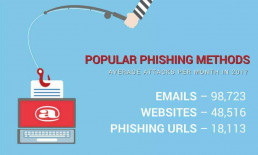
The Facts Behind Phishing
A report from the Anti-Phishing Working Group (APWG) showed that companies responding to their survey experienced a steady stream of phishing scams during the first half of 2018. The most targeted business sectors were:
- Payment Providers
- Financial Institutions
- SAAS/Webmail
- Cloud Storage/Cloud Hosting
Popular Phishing Methods
Responses to the APWG survey showed the below methods being used the most:
Emails – The most popular tool for attackers at an average of 98,723 per month.
Websites – Attempts using this method averaged 48,516 per month.
Phishing URLs – Averaged around 18,113 attempts per month.
Hackers targeted a small number of brands at an average of 443 times per month. APWG contributor PhishLabs noted an uptick in free web hosting sites being used to build malicious websites. They do this to lend credibility to the site being built by using an established provider.
76% of companies experienced some type of phishing attack. That number rose in the first quarter of 2018 to 81% for US companies. Businesses saw a rise in malware infections of 49%, up from 27% in 2017.
Other security stats suggest that spear phishing accounted for 53% of phishing campaigns worldwide. That number went up to 57% for the United States. Phone calls and text messages, on the other hand, accounted for 45% of phishing attempts worldwide.
Things have come a long way since the days of the Nigerian prince scam emails. Hackers use more sophisticated phishing email methods.
They come with stolen or altered business logos to trick the recipient. Or they infiltrate social networking platforms, disguising themselves as a friend or someone who shares your interests.
Common Types Of Phishing Attacks & How To Identify
Email Phishing
Email remains a popular choice for most attackers. They mimic a popular brand or institution reaching out to you to help you resolve an issue. The official-looking communication asks you to confirm a password or other account information.
More sophisticated deceptive phishing emails make the sender address match those of people or businesses you communicate with regularly. They contain malicious attachments or links designed to deliver malware to your device.
Spear Phishing Attacks
Cyber attackers use this phishing technique to target particular businesses. They go beyond sending out mass emails or blanketing random sites with ads. They tailor their efforts toward people who work in an industry they find valuable.
Target became the victim of a spear phishing attack when information on nearly 40 million customers was stolen during a cyber attack. Hackers went after a third-party vendor used by the company. They captured their credentials and used them to access the customer information from a database using malware downloaded from a malicious attachment.
Whaling
John Podesta, the chairman of Hillary Clinton’s presidential campaign, found out about whaling the hard way. His account received an email purporting to be a Google alert letting him know his system had been compromised. It was urgent that his credentials be reset immediately at the link provided.
His assistant did just that after receiving erroneous information from their IT person that it was legitimate. That is all it took for malicious spyware to be released into their systems. Thousands of document and emails were stolen by Russian hackers.
Whaling attacks target high-level executives with credentials giving them access to a wide range of information. Factors like human error and lousy advice play a big part in the success of these type of attacks.
Clone Phishing
Cloning involves mimicking a trusted site a user frequents. People receive emails warning them about an issue with their account. Hackers create an entire malicious website that looks like the one the user logs into regularly.
The attackers hope to fool users into providing them with personal credentials. Many users of Reddit fell victim to clone phishing. A clone of the site popped up with the apparent intent of tricking people into thinking they were logging into the regular Reddit site.
Phone and Text Phishing
Not all attacks come over the internet. Many businesses use automated voice messages to alert people to things like an upcoming doctor appointment. Hackers use this method to leave voicemails warning you about an issue. They may reference your bank account or a company you’ve obtained services from.
Hackers employ similar methods using text messages. This allows them to send you malicious links directing you to a phishing website. Once you get there, they mask the address bar with a picture of a real URL to fool you into thinking you are on an actual site.
Social Media
Phishing attacks tend to go after a large pool of targets on platforms like Facebook or other favorite social media sites. You receive a request from a friend asking you to respond to a quiz. It asks questions like “What are your favorite vacation spots close to home?” or something equally innocuous.
The information you give out may seem like nothing. You might reference where you live and places you like to visit. Hackers need only a small bit of data to gain more information about you. That is enough to figure out your passwords and hack your accounts.
Thieves use the pictures posted to your Instagram or Snapchat account as sources of information. Korean officials at the 2018 Winter Games warned people not to post pictures of their tickets since they contained a barcode. Hackers could scan the pictures and capture all of their personal data.
Fraudulent Websites
Hackers build fake phishing sites designed to steal your information. For example, people searching for a site that lets them update a passport get fooled by a login page that appears legitimate. The credentials they enter end up being used to compromise other personal accounts.
Scammers also lure visitors to these sites by creating fake ads on sites like Google or Craigslist. Bitcoin users fooled by fake ads on Google have been frequent victims of theft in recent months. The problem got so bad that Facebook recently banned all ads related to cryptocurrencies from their site.
False or Fake Advertisements
Websites make a significant amount of revenue by designing ads that get your attention. Hackers use this to their advantage by embedding these ads with malware. Clicking on the ads allows the software to embed itself in your system and go to work.

How to Prevent Phishing
It only takes one moment of inattention to make yourself or your company the victim of identity theft. While there is no easy way to prevent phishing, a multi-pronged approach to combating the threat can minimize the risk.
1. Protect Your Inbox
The best defense is a good offense. Stop potentially damaging emails from entering company inboxes by using strong email spam filters and following email security best practices. Most security software companies offer versions compatible with both computer and mobile devices.
Your software should automatically scan any links or attachments. This prevents new or unrecognizable URLs from sneaking past company safeguards. New computer network security threats show up every day. Hackers also continuously work to evolve and hide malware. Keeping your software updated and running continuously is essential.
2. Analyze Web Traffic
Attackers love to find vulnerable points when users access personal accounts on their work computers. Check any access attempts to non-company websites or email servers. It does no good to have top-level security on a work email account, only to have someone download malware by clicking on a Facebook ad.
3. Raise Employees’ Security Awareness
Human error still accounts for the majority of data breaches. Hackers only need one person in an organization to click on the malicious link in an email to cause damage. Multiple steps should be taken to train employees on how to recognize phishing and handle them appropriately.
First of all, employees need to understand that they are all potential victims of cybercrime. They need to be educated on the most common threats. Companies should provide comprehensive training on how to recognize a phishing message, social engineering tactics, and suspicious web addresses.
The training should also cover identity management, as well as cloud security and mobile security to enable employees to protect themselves.
4. Test Employees on how to identify a phishing email
Establish a security awareness program.
Target specific people within different areas of your company with test phishing emails. Track those who correctly identify suspicious emails versus those who do not. Interview them to gain insight as to why they did or did not recognize the problems within. Use that feedback to modify or redesign your cyber security training courses.
In addition to testing employees, you should also regularly check the stability of your critical infrastructure. If you are hosting your data with a third-party data center provider, you should ensure it provides advanced protection against the most common threats such as DDoS, phishing, and ransomware attacks.
If your entire infrastructure is managed internally, you need to ensure you have all these systems in place to keep your data safe. You should also consider running a penetration test every once in a while to be confident about your platform’s security.
5. Communicate Effectively Between Departments
One of the easiest ways to manage passwords is with a corporate password management solution.
Make sure your employees understand the recommended cybersecurity best practices for companies and receive frequent reminders about their importance. Coordinate across all departments so that everyone gets the same education.
6. Use A Variety of Teaching Methods
Everyone absorbs information differently. Some prefer visual cues, while others like thing documented in a manual to refer back to. You also have those who prefer to gain knowledge audibly. Provide your employees with different options to obtain online security education.
7. Make Phishing Training Personal
Employees often cannot comprehend how their actions could hurt the entire company. Bring it down from an abstract and show how it affects them. Demonstrate how the damage done by malicious software impacts their job.
8. Create a Tutorial On What Not To Share
Cyber thieves continuously scour social media for information posted by employees of companies they are targeting.
Advise them to avoid sharing information like:
- Birthdays
- Personal Address
- Phone Numbers
- Vacation Days
- Online Banking and Credit Card Details
Attackers use this information to guess at passwords they use to access accounts at work. Letting people know when you will be away from your computer gives hackers a window of opportunity to target you while you are not there.
9. Establish a System to Report Threats
Inform employees on what to do if they encounter a fraudulent email. They should report even if they are unsure if the message is a threat. They should also beware random text messages seeming like official communications from the company.
10. Celebrate Cybersecurity Due Diligence
Show employees your appreciation for following security protocols. Prepare a luncheon or off-site event to show your company’s appreciation for the dedication shown by workers to keeping company information safe.

Types Of Malware Used In Phishing Attacks
Hackers come up with new types of malware every day. The term malware covers various types of malicious software designed to gain access to information on a user’s device.
Botnet Malware
Hackers in recent years started using computer networks designed to take control of devices in your home or business to launch malicious attacks. Remote controllers manipulate these malevolent botnets to turn your devices against you.
The laptop you use for work become a tool to steal your information. New technology like Amazon Echo speakers also presents new frontiers for hackers. The growing attacks on IoT (Internet of Things) devices make the consequences of phishing more severe.
The threat of botnets increased in 2018 with over 40% of automated login attempts to websites being malicious. The hospitality sector was the hardest hit with an 82% malicious login rate. Botnets leverage the fact that most people use the same account credentials to access multiple sites.
After obtaining credentials, the botnets attack site after site. This only stops once the user becomes aware of the theft and changes their information.
Ransomware
The rise of ransomware in the last decade brought a new type of danger to deal with. This software locks users out of the files in their system. Hackers demand payment in exchange for removing the malware and giving back access.
Sony Pictures found itself the victim of such an attack in 2014 and again in 2017. It is not just businesses being targeted. The government of the town of Yarrow Point in Washington grappled with frequent ransomware attacks throughout 2018. Find out how to protect yourself from ransomware.
Computer Viruses
Code or software engineered to disrupt the way a device functions. They attach themselves to legitimate programs for code execution, often corrupting or destroying system files along the way.
Trojan horse
Disguises itself as a legitimate program within an email. They open the door to access the user’s information once executed.
Spyware
These programs embed themselves in your device to record your activities. They track sites you visit and capture any personal details entered by you.
Worm
These programs require nothing from your system. They are self-sustaining and duplicate themselves everywhere without needing human interaction.
Learn To Identify Phishing Attacks
The best defense against all types of phishing attacks is to learn to identify them.
Learn about the deceptive tactics used to obtain information. Do not let your company become a statistic and being used as an example to other businesses.
Recent Posts
Cloud Security Tips to Reduce Security Risks, Threats, & Vulnerabilities
Do you assume that your data in the cloud is backed up and safe from threats? Not so fast.
With a record number of cybersecurity attacks taking place in 2018, it is clear that all data is under threat.
Everyone always thinks “It cannot happen to me.” The reality is, no network is 100% safe from hackers.
According to the Kaspersky Lab, ransomware rose by over 250% in 2018 and continues to trend in a very frightening direction. Following the advice presented here is the ultimate insurance policy from the crippling effects of a significant data loss in the cloud.
How do you start securing your data in the cloud? What are the best practices to keep your data protected in the cloud? How safe is cloud computing?
To help you jump-start your security strategy, we invited experts to share their advice on Cloud Security Risks and Threats.
Key Takeaways From Our Experts on Cloud Protection & Security Threats
- Accept that it may only be a matter of time before someone breaches your defenses, plan for it.
- Do not assume your data in the cloud is backed up.
- Enable two-factor authentication and IP-location to access cloud applications.
- Leverage encryption. Encrypt data at rest.
- The human element is among the biggest threats to your security.
- Implement a robust change control process, with weekly patch management cycle.
- Maintain offline copies of your data to in the event your cloud data is destroyed or held ransom.
- Contract with 24×7 security monitoring service.
- Have an security cident response plan.
- Utilize advanced firewall technology including WAF (Web Access Firewalls).
- Take advantage of application services, layering, and micro-segmentation.
1. Maintain Availability In The Cloud

When most people think about the topic of cloud-based security, they tend to think about Networking, Firewalls, Endpoint security, etc. Amazon defines cloud security as:
Security in the cloud is much like security in your on-premises data centers – only without the costs of maintaining facilities and hardware. In the cloud, you do not have to manage physical servers or storage devices. Instead, you use software-based security tools to monitor and protect the flow of information into and of out of your cloud resources.
But one often overlooked risk is maintaining availability. What I mean by that is more than just geo-redundancy or hardware redundancy, I am referring to making sure that your data and applications are covered. Cloud is not some magical place where all your worries disappear; a cloud is a place where all your fears are often easier and cheaper to multiply. Having a robust data protection strategy is key. Veeam has often been preaching about the “3-2-1 Rule” that was coined by Peter Krogh.
The rule states that you should have three copies of your data, storing them on two different media, and keeping one offsite. The one offsite is usually in the “cloud,” but what about when you are already in the cloud?
This is where I see most cloud issues arise, when people are already in the cloud they tend to store the data in the same cloud. This is why it is important to remember to have a detailed strategy when moving to the cloud. By leveraging things like Veeam agents to protect cloud workloads and Cloud Connect to send the backups offsite to maintain that availability outside of the same datacenter or cloud. Don’t assume that it is the providers’ job to protect your data because it is not.
2. Cloud MIgration is Outpacing The Evolution of Security Controls

According to a new survey conducted by ESG, 75% of organizations said that at least 20% of their sensitive data stored in public clouds is insufficiently secured. Also, 81% of those surveyed believe that on-premise data security is more mature than public cloud data.
Yet, businesses are migrating to the cloud faster than ever to maximize organizational benefits: an estimated 83% of business workloads will be in the cloud by 2020, according to LogicMonitor’s Cloud Vision 2020 report. What we have is an increasingly urgent situation in which organizations are migrating their sensitive data to the cloud for productivity purposes at a faster rate than security controls are evolving to protect that data.
Companies must look at solutions that control access to data within cloud shares based on the level of permission that user has, but they must also have the means to be alerted when that data is being accessed in unusual or suspicious ways, even by what appears to be a trusted user.
Remember that many hackers and insider leaks come from bad actors with stolen, legitimate credentials that allow them to move freely around in a cloud share, in search of valuable data to steal. Deception documents, called decoys, can also be an excellent tool to detect this. Decoys can alert security teams in the early stage of a cloud security breach to unusual behaviors, and can even fool a would-be cyber thief into thinking they have stolen something of value when in reality, it’s a highly convincing fake document. Then, there is the question of having control over documents even when they have been lifted out of the cloud share.
This is where many security solutions start to break down. Once a file has been downloaded from a cloud repository, how can you track where it travels and who looks at it? There must be more investment in technologies such as geofencing and telemetry to solve this.
3. Minimize Cloud Computing Threats and Vulnerabilities With a Security Plan

The Hybrid cloud continues to grow in popularity with the enterprise – mainly as the speed of deployment, scalability, and cost savings become more attractive to business. We continue to see infrastructure rapidly evolving into the cloud, which means security must develop at a similar pace. It is essential for the enterprise to work with a Cloud Service Provider who has a reliable approach to security in the cloud.
This means the partnership with your Cloud Provider is becoming increasingly important as you work together to understand and implement a security plan to keep your data secure.
Security controls like Multi-factor authentication, data encryption along with the level of compliance you require are all areas to focus on while building your security plan.
4. Never Stop Learning About Your Greatest Vulnerabilities
Isacc Kohen, CEO of Teramind
More and more companies are falling victim to the cloud, and it has to do with cloud misconfiguration and employee negligence.
1. The greatest threats to data security are your employees. Negligent or malicious, employees are one of the top reasons for malware infections and data loss. The reasons why malware attacks and phishing emails are common words in the news is because they are ‘easy’ ways for hackers to access data. Through social engineering, malicious criminals can ‘trick’ employees into giving passwords and credentials over to critical business and enterprise data systems. Ways to prevent this: an effective employee training program and employee monitoring that actively probes the system
2. Never stop learning. In an industry that is continuously changing and adapting, it is important to be updated on the latest trends and vulnerabilities. For example with the Internet of Things (IoT), we are only starting to see the ‘tip of the iceberg’ when it comes to protecting data over increased wi-fi connections and online data storage services. There’s more to develop with this story, and it will have a direct impact on small businesses in the future.
3. Research and understand how the storage works, then educate. We’ve heard the stories – when data is exposed through the cloud, many times it’s due to misconfiguration of the cloud settings. Employees need to understand the security nature of the application and that the settings can be easily tampered with and switched ‘on’ exposing data externally. Educate security awareness through training programs.
4. Limit your access points. An easy way to mitigate this, limit your access points. A common mistake with cloud exposure is due to when employees with access by mistake enable global permissions allowing the data exposed to an open connection. To mitigate, understand who and what has access to the data cloud – all access points – and monitor those connections thoroughly.
5. Monitoring the systems. Progressive and through. For long-term protection of data on the cloud, use a user-analytics and monitoring platform to detect breaches quicker. Monitoring and user analytics streamlines data and creates a standard ‘profile’ of the user – employee and computer. These analytics are integrated and following your most crucial data deposits, which you as the administrator indicated in the detection software. When specific cloud data is tampered with, moved or breached, the system will “ping” an administrator immediately indicating a change in character.
5. Consider Hybrid Solutions

There are several vital things to understand about security in the cloud:
1. Passwords are power – 80% of all password breaches could have been prevented by multifactor identification: by verifying your personal identity via text through to your phone or an email to your account, you can now be alerted when someone is trying to access your details.
One of the biggest culprits at the moment is weakened credentials. That means passwords, passkeys, and passphrases are stolen through phishing scams, keylogging, and brute-force attacks.
Passphrases are the new passwords. Random, easy-to-remember passphrases are much better than passwords, as they tend to be longer and more complicated.
MyDonkeysEatCheese47 is a complicated passphrase and unless you’re a donkey owner or a cheese-maker, unrelated to you. Remember to make use of upper and lowercase letters as well as the full range of punctuation.
2. Keep in touch with your hosting provider. Choose the right hosting provider – a reputable company with high-security standards in place. Communicate with them regularly as frequent interaction allows you to keep abreast of any changes or developing issues.
3. Consider a hybrid solution. Hybrid solutions allow for secure, static systems to store critical data in-house while at the same time opening up lower priority data to the greater versatility of the cloud.
6. Learn How Cloud Security Systems Work

Businesses need to make sure they evaluate cloud computing security risks and benefits. It is to make sure that they educate themselves on what it means to move into the cloud before taking that big leap from running systems in their own datacenter.
All too often I have seen a business migrate to the cloud without a plan or any knowledge about what it means to them and the security of their systems. They need to recognize that their software will be “living” on shared systems with other customers so if there is a breach of another customer’s platform, it may be possible for the attacker to compromise their system as well.
Likewise, cloud customers need to understand where their data will be stored, whether it will be only in the US, or the provider replicates to other systems that are on different continents. This may cause a real issue if the information is something sensitive like PII or information protected under HIPAA or some other regulatory statute. Lastly, the cloud customer needs to pay close attention to the Service Level Agreements (SLA) that the cloud provider adheres to and ensure that it mirrors their own SLA.
Moving to the cloud is a great way to free up computing resources and ensure uptime, but I always advise my clients to make a move in small steps so that they have time to gain an appreciation for what it means to be “in the cloud.”
7. Do Your Due Diligence In Securing the Cloud

Understand the type of data that you are putting into the cloud and the mandated security requirements around that data.
Once a business has an idea of the type of data they are looking to store in the cloud, they should have a firm understanding of the level of due diligence that is required when assessing different cloud providers. For example, if you are choosing a cloud service provider to host your Protected Health Information (PHI), you should require an assessment of security standards and HIPAA compliance before moving any data into the cloud.
Some good questions to ask when evaluating whether a cloud service provider is a fit for an organization concerned with securing that data include: Do you perform regular SOC audits and assessments? How do you protect against malicious activity? Do you conduct background checks on all employees? What types of systems do you have in place for employee monitoring, access determination, and audit trails?
8. Set up Access Controls and Security Permissions

While the cloud is a growing force in computing for its flexibility for scaling to meet the needs of a business and to increase collaboration across locations, it also raises security concerns with its potential for exposing vulnerabilities relatively out of your control.
For example, BYOD can be a challenge to secure if users are not regularly applying security patches and updates. The number one tip I would is to make the best use of available access controls.
Businesses need to utilize access controls to limit security permissions to allow only the actions related to the employees’ job functions. By limiting access, businesses assure critical files are available only to the staff needing them, therefore, reducing the chances of their exposure to the wrong parties. This control also makes it easier to revoke access rights immediately upon termination of employment to safeguard any sensitive content within no matter where the employee attempts access from remotely.
9. Understand the Pedigree and Processes of the Supplier or Vendor

The use of cloud technologies has allowed businesses of all sizes to drive performance improvements and gain efficiency with more remote working, higher availability and more flexibility.
However, with an increasing number of disparate systems deployed and so many cloud suppliers and software to choose from, retaining control over data security can become challenging. When looking to implement a cloud service, it is essential to thoroughly understand the pedigree and processes of the supplier/vendor who will provide the service. Industry standard security certifications are a great place to start. Suppliers who have an ISO 27001 certification have proven that they have met international information security management standards and should be held in higher regard than those without.
Gaining a full understanding of where your data will to geographically, who will have access to it, and whether it will be encrypted is key to being able to protect it. It is also important to know what the supplier’s processes are in the event of a data breach or loss or if there is downtime. Acceptable downtime should be set out in contracted Service Level Agreements (SLAs), which should be financially backed by them provide reassurance.
For organizations looking to utilize cloud platforms, there are cloud security threats to be aware of, who will have access to data? Where is the data stored? Is my data encrypted? But for the most part cloud platforms can answer these questions and have high levels of security. Organizations utilizing the clouds need to ensure that they are aware of data protection laws and regulations that affect data and also gain an accurate understanding of contractual agreements with cloud providers. How is data protected? Many regulations and industry standards will give guidance on the best way to store sensitive data.
Keeping unsecured or unencrypted copies of data can put it at higher risk. Gaining knowledge of security levels of cloud services is vital.
What are the retention policies, and do I have a backup? Cloud platforms can have widely varied uses, and this can cause (or prevent) issues. If data is being stored in a cloud platform, it could be vulnerable to cloud security risks such as ransomware or corruption so ensuring that multiple copies of data are retained or backed up can prevent this. Guaranteeing these processes have been taken improves the security levels of an organizations cloud platforms and gives an understanding of where any risk could come from
10. Use Strong Passwords and Multi-factor Authentication

Ensure that you require strong passwords for all cloud users, and preferably use multi-factor authentication.
According to the 2017 Verizon Data Breach Investigations Report, 81% of all hacking-related breaches leveraged either stolen and/or weak passwords. One of the most significant benefits of the Cloud is the ability to access company data from anywhere in the world on any device. On the flip side, from a security standpoint, anyone (aka “bad guys”) with a username and password can potentially access the businesses data. Forcing users to create strong passwords makes it vastly more difficult for hackers to use a brute force attack (guessing the password from multiple random characters.)
In addition to secure passwords, many cloud services today can utilize an employee’s cell phone as the secondary, physical security authentication piece in a multi-factor strategy, making this accessible and affordable for an organization to implement. Users would not only need to know the password but would need physical access to their cell phone to access their account.
Lastly, consider implementing a feature that would lock a user’s account after a predetermined amount of unsuccessful logins.
11. Enable IP-location Lockdown

Companies should enable two-factor authentication and IP-location lockdown to access to the cloud applications they use.
With 2FA, you add another challenge to the usual email/password combination by text message. With IP lockdown you can ring-fence access from your office IP or the IP of remote workers. If the platform does not support this, consider asking your provider to enable it.
Regarding actual cloud platform provision, provide a data at rest encryption option. At some point, this will become as ubiquitous as https (SSL/TLS). Should the unthinkable happen and data ends up in the wrong hands, i.e., a device gets stolen or forgotten on a train, then data at rest encryption is the last line of defense to prevent anyone from accessing your data without the right encryption keys. Even if they manage to steal it, they cannot use it. This, for example, would have ameliorated the recent Equifax breach.
12. Cloud Storage Security Solutions With VPN’s

Use VPNs (virtual private networks) whenever you connect to the cloud. VPNs are often used to semi-anonymize web traffic, usually by viewers that are geoblocked by accessing streaming services such as Netflix USA or BBC Player. They also provide a crucial layer of security for any device connecting to your cloud. Without a VPN, any potential intruder with a packet sniffer could determine what members were accessing your cloud account and potentially gain access to their login credentials.
Encrypt data at rest. If for any reason a user account is compromised on your public, private or hybrid cloud, the difference between data in plaintext vs. encrypted format can be measured in hundreds of thousands of dollars — specifically $229,000, the average cost of a cyber attack reported by the respondents of a survey conducted by the insurance company Hiscox. As recent events have shown, the process of encrypting and decrypting this data will prove far more painless than enduring its alternative.
Use two-factor authentication and single sign-on for all cloud-based accounts. Google, Facebook, and PayPal all utilize two-factor authentication, which requires the user to input a unique software-generated code into a form before signing into his/her account. Whether or not your business aspires to their stature, it can and should emulate this core component of their security strategy. Single sign-on simplifies access management, so one pair of user credentials signs the employee into all accounts. This way, system administrators only have one account to delete rather than several that can be forgotten and later re-accessed by the former employee.
13. Beware of the Human Element Risk

To paraphrase Shakespeare, the fault is not in the cloud; the responsibility is in us.
Storing sensitive data in the cloud is a good option for data security on many levels. However, regardless of how secure a technology may be, the human element will always present a potential security danger to be exploited by cybercriminals. Many past cloud security breached have proven not to be due to security lapses by the cloud technology, but rather by actions of individual users of the cloud.
They have unknowingly provided their usernames and passwords to cybercriminals who, through spear phishing emails, phone calls or text messages persuade people to give the critical information necessary to access the cloud account.
The best way to avoid this problem, along with better education of employees to recognize and prevent spear phishing, is to use dual factor authentication such as having a one time code sent to the employee’s cell phone whenever the cloud account is attempted to be accessed.
14. Ensure Data Retrieval From A Cloud Vendor

1. Two-factor authentication protects against account fraud. Many users fail victim to email phishing attempts where bad actors dupe the victim into entering their login information on a fake website. The bad actor can then log in to the real site as the victim, and do all sorts of damage depending on the site application and the user access. 2FA ensures a second code must be entered when logging into the application. Usually, a code sent to the user’s phone.
2. Ensuring you own your data and that can retrieve it in the event you no longer want to do business with the cloud vendor is imperative. Most legitimate cloud vendors should specify in their terms that the customer owns their data. Next, you need to confirm you can extract or export the data in some usable format, or that the cloud vendor will provide it to you on request.
15. Real Time and Continuous Monitoring

1. Create Real-Time Security Observability & Continuous Systems Monitoring
While monitoring is essential in any data environment, it’s critical to emphasize that changes in modern cloud environments, especially those of SaaS environments, tend to occur more frequently; their impacts are felt immediately.
The results can be dramatic because of the nature of elastic infrastructure. At any time, someone’s accidental or malicious actions could severely impact the security of your development, production, or test systems.
Running a modern infrastructure without real-time security observability and continuous monitoring is like flying blind. You have no insight into what’s happening in your environment, and no way to start immediate mitigation when an issue arises. You need to monitor application and host-based access to understand the state of your application over time.
- Monitoring systems for manual user actions. This is especially important in the current DevOps world where engineers are likely to have access to production. It’s possible they are managing systems using manual tasks, so use this as an opportunity to identify processes that are suited for automation.
- Tracking application performance over time to help detect anomalies. Understanding “who did what and when” is fundamental to investigating changes that are occurring in your environment.
2. Set & Continuously Monitor Configuration Settings
Security configurations in cloud environments such as Amazon Direct Connect can be complicated, and it is easy to inadvertently leave access to your systems and data open to the world, as has been proven by all the recent stories about S3 leaks.
Given the changeable (and sometimes volatile) nature of SaaS environments, where services can be created and removed in real time on an ongoing basis, failure to configure services appropriately, and failure to monitor settings can jeopardize security. Ultimately, this will erode the trust that customers are placing in you to protect their data.
By setting configurations against an established baseline and continuously monitoring them, you can avoid problems when setting up services, and you can detect and respond to configuration issues more quickly when they occur.
3. Align Security & Operations Priorities for Cloud Security Solutions and Infrastructure
Good security is indistinguishable from proper operations. Too often these teams are at odds inside an organization. Security is sometimes seen as slowing down a business— overly focused on policing the activities of Dev and Ops teams. But security can be a business enabler.
Security should leverage automation testing tools, security controls and monitoring inside an organization — across network management, user access, the configuration of infrastructure, and vulnerability management across application layer — will drive the business forward, reducing risk across the attack surface and maintaining operational availability.
16. Use Auditing Tools to Secure Data In the Cloud

1. Use an auditing tool so that you know what all you have in the cloud and what all of your users are using in the cloud. You can’t secure data that you don’t know about.
2. In addition to finding out what services are being run on your network, find out how and why those services are being used, by whom and when.
3. Make that auditing process a routine part of your network monitoring, not just a one-time event. Moreover, if you don’t have the bandwidth for that, outsource that auditing routine to a qualified third party like US Cloud.
17. Most Breaches Start At Simple Unsecured Points

The cloud is very secure, but to ensure you are keeping company data secure it is important to configure the cloud properly.
For AWS specifically, AWS Config is the tool best utilized to do this. AWS, when configured the right way, is one of the most secure cloud computing environments in the world. However, most data breaches are not hackers leveraging complex programs to get access to critical data, but rather it’s the simple unsecured points, the low hanging fruit, that makes company data vulnerable.
Even with the best cloud security, human error is often to blame for the most critical gap or breach in protection. Having routines to validate continuous configuration accuracy is the most underused and under-appreciated metric for keeping company data secure in the cloud.
18. Ask Your Cloud Vendor Key Security Questions

When exploring the possibilities of moving to a cloud-based solution, you should ensure adequate supports are in place should a breach occur. Make sure you ask the following questions before signing an agreement with a cloud-based provider:
Question: How many third-parties does the provider use to facilitate their service?
Reason for question (Reason): Processes and documentation will need to be updated to include procedural safeguards and coordination with the cloud-based solution. Additionally, the level of security provided by the cloud-based provider should be clearly understood. Increased levels of security made need to be added to meet privacy and security requirements for the data being stored.
Question: How will you be notified if a breach of their systems occurs and will they assist your company in the notification of your clients/customers?
Reason: By adding a cloud-based solution to the storage of your data also adds a new dimension of time to factor into the notification requirements that may apply to your data should a breach occur. These timing factors should be incorporated into breach notification procedures and privacy policies.
When switching to the cloud from a locally hosted solution your security risk assessment process needs to be updated. Before making the switch, a risk assessment should take place to understand the current state of the integrity of the data that will be migrated.
Additionally, research should be done to review how data will be transferred to the cloud environment. Questions to consider include:
Question: Is your data ready for transport?
Reason: The time to conduct a data quality assessment is before migrating data to a cloud-based solution rather than after the fact.
Question: Will this transfer be facilitated by the cloud provider?
Reason: It is important to understand the security parameters that are in place for the transfer of data to the cloud provider, especially when considering large data sets.
19. Secure Your Cloud Account Beyond the Password
Contributed by the team at Dexter Edward
Secure the cloud account itself. All the protection on a server/os/application won’t help if anyone can take over the controls.
- Use a strong and secure password on the account and 2-factor authentication.
- Rotate cloud keys/credentials routinely.
- Use IP whitelists.
- Use any role-based accesses on any associated cloud keys/credentials.
Secure access to the compute instances in the cloud.
- Use firewalls provided by the cloud providers.
- Use secure SSH keys for any devices that require login access.
- Require a password for administrative tasks.
- Construct your application to operate without root privilege.
- Ensure your applications use encryption for any communications outside the cloud.
- Use authentication before establishing public communications.
Use as much of the private cloud network as you can.
- Avoid binding services to all public networks.
- Use the private network to isolate even your login access (VPN is an option).
Take advantage of monitoring, file auditing, and intrusion detection when offered by cloud providers.
- The cloud is made to move – use this feature to change up the network location.
- Turn off instances when not in use. b. Keep daily images so you can move the servers/application around the internet more frequently.
20. Consider Implementing Managed Virtual Desktops
Michael Abboud, CEO, and Founder of TetherView
Natural disasters mixed with cyber threats, data breaches, hardware problems, and the human factor, increase the risk that a business will experience some type of costly outage or disruption.
Moving towards managed virtual desktops delivered via a private cloud, provides a unique opportunity for organizations to reduce costs and provide secure remote access to staff while supporting business continuity initiatives and mitigating the risk of downtime.
Taking advantage of standby virtual desktops, a proper business continuity solution provides businesses with the foundation for security and compliance.
The deployment of virtual desktops provides users with the flexibility to work remotely via a fully-functional browser-based environment while simultaneously allowing IT departments to centrally manage endpoints and lock down business critical data. Performance, security, and compliance are unaffected.
Standby virtual desktops come pre-configured and are ready to be deployed instantaneously, allowing your team to remain “business as usual” during a sudden disaster.
In addition to this, you should ensure regular data audits and backups
If you don’t know what is in your cloud, now is the time to find out. It’s essential to frequently audit your data and ensure everything is backed up. You’ll also want to consider who has access to this data. Old employees or those who no longer need access should have permissions provoked.
It’s important to also use the latest security measures, such as multi-factor authentication and default encryption. Always keep your employees up to speed with these measures and train them to spot potential threats that way they know how to deal with them right away.
21. Be Aware of a Provider’s Security Policies

Many, if not most, businesses will continue to expand in the cloud, while relying on on-premise infrastructure for a variety of reasons, ranging from a simple cost/benefit advantages to reluctance to entrust key mission-critical data or systems into the hands of third-party cloud services providers. Keeping track of what assets are where in this hybrid environment can be tricky and result in security gaps.
Responsibility for security in the cloud is shared between the service provider and the subscriber. So, the subscriber needs to be aware not only of the service provider’s security policies, but also such mundane matters as hardware refresh cycles.
Cyber attackers have become adept at finding and exploiting gaps in older operating systems and applications that may be obsolete, or which are no longer updated. Now, with the disclosure of the Spectre and Meltdown vulnerabilities, we also have to worry about threats that could exploit errors or oversights hard-coded at the chip level.
Hardware such as servers and PCs has a limited life cycle, but often businesses will continue to operate these systems after vendors begin to withdraw support and discontinue firmware and software updates needed to counter new security threats.
In addition to being aware of what their cloud provider is doing, the business must keep track of its own assets and refresh them or decommission them as needed. When computer systems are repurposed for non-critical purposes, it is too easy for them to fall outside of risk management and security oversight.
22. Encrypt Backups Before Sending to the Cloud
Mikkel Wilson, CTO at Oblivious.io
1. File metadata should be secured just as vigilantly as the data itself. Even if an attacker can’t get at the data you’ve stored in the cloud, if they can get, say, all the filenames and file sizes, you’ve leaked important information. For example, if you’re a lawyer and you reveal that you have a file called “michael_cohen_hush_money_payouts.xls” and it’s 15mb in size, this may raise questions you’d rather not answer.
2. Encrypt your backups *before* you upload them to the cloud. Backups are a high-value target for attackers. Many companies, even ones with their own data centers, will store backups in cloud environments like Amazon S3. They’ll even turn on the encryption features of S3. Unfortunately, Amazon stores the encryption keys right along with the data. It’s like locking your car and leaving the keys on the hood.
23. Know Where Your Data Resides To Reduce Cloud Threats

Be aware of where their data is stored these days so that they can proactively identify if any of the data may be at risk of a breach.
These days, data is being stored in multiple cloud locations and applications in addition to storage devices in business. Companies are adopting cloud storage services such as Google Drive, Dropbox, OneDrive, etc. and online software services for all kind of business processes. This has led to vast fragmentation of company data, and often managers have no idea where all the data may be.
For example, a confidential financial report for the company may get stored in cloud storage because devices are automatically synching with cloud or a sensitive business conversation may happen in cloud-based messaging services such as Slack. While cloud companies have all the right intentions to keep their customer data safe, they are also the prime target because hackers have better ROI in targeting such services where they can potentially get access to data for millions of subscribers.
So, what should a company do?
While they will continue to adopt cloud services and their data will end up in many, many locations, they can use some search and data organization tools that can show them what data exists in these services. Using full-text search capabilities, they can then very quickly find out if any of this information is a potential risk to the company if breached. You cannot protect something if you do not even know where it is. And more importantly, you will not even know if it is stolen. So, companies looking to protect their business data need to take steps at least to be aware of where all their information is.
24. Patch Your Systems Regularly To Avoid Cloud Vulnerabilities

Business users are not defenseless, even in the wake of recent attacks on cloud computing like WannaCry or Petya/NotPetya.
The best antidote is patch management. It is always sound practice to keep systems and servers up to date with patches – it is the shortest path to peace of mind. Indeed, “patch management consciousness” needs to be part of an overarching mantra that security is a process, not an event — a mindset, not a matter of checking boxes and moving on. Vigilance should be everyone’s default mode.
Spam is no one’s friend; be wary of emails from unknown sources – and that means not opening them. Every small and midsize business wins by placing strategic emphasis on security protections, with technologies like clustered firewalls and intrusion detection and prevention systems (IDPS).
25. Security Processes Need Enforcement as Staff Often Fail to Realize the Risk

1. Security as a Priority
Enforcing security measures can become difficult when working with deadlines or complex new features. In an attempt to drive their products forward, teams often bend the rules outlined in their own security process without realizing the risk they are putting their company into. A well thought out security process needs to be well enforced in order achieve its goal in keeping your data protected. Companies that include cloud security as a priority in their product development process drastically reduce their exposure to lost data and security threats.
2. Passwords & Encryption
Two important parts of securing your data in the cloud are passwords and encryption.
Poor password management is the most significant opportunity for bad actors to access and gain control of company data. This usually accomplished through social engineering techniques (like phishing emails) mostly due to poor employee education. Proper employee training and email monitoring processes go a long way in helping expose password information. Additionally, passwords need to be long, include numbers, letters, and symbols. Passwords should never be written down, shared in email, or posted in chat and ticket comments. An additional layer of data protection is achieved through encryption. If your data is being stored for in the cloud for long periods, it should be encrypted locally before you send it up. This makes the data practically inaccessible in the small chance it is compromised.
26. Enable Two-factor Authentication

For the best cloud server security, we prefer to see Two Factor Authentication (also known as 2FA, multi-factor authentication, or two-step authentication) used wherever possible.
What is this? 2 Factor combines “something you know” with “something you have.” If you need to supply both a password and a unique code sent to your smartphone via text, then you have both those things. Even if someone knows your password, they still can’t get into your account. They would have to know your password and have access to your cell phone. Not impossible, but you have just dramatically made it more difficult for them to hack your account. They will look elsewhere for an easier target. As an example, iCloud and Gmail support 2FA – two services very popular with business users. I recommend everyone use it.
Why is this important for cloud security?
Because cloud services are often not protected by a firewall or other mechanism to control where the service can be accessed from. 2FA is an excellent additional layer to add to security. I should mention as well that some services, such as Salesforce, have a very efficient, easy to use implementation of 2FA that isn’t a significant burden on the user.
27. Do Not Assume Your Data in the Cloud is Backed-Up

Backing up data that’s in the cloud: There’s a big misconception around how cloud-based platforms (ex. Shopify, QuickBooks Online, Mailchimp, Wordpress) are backed up. Typically, cloud-based apps maintain a disaster recovery cloud backup of the entire platform. If something were to happen to their servers, they would try to recover everyone’s data to the last backup. However, as a user, you don’t have access to their backup to restore your data.
This means that you risk having to manually undo unwanted changes or permanently losing data if:
- A 3rd party app integrated into your account causes problems.
- You need to unroll a series of changes
- Your or someone on your team makes a mistake
- A disgruntled employee or contractor deletes data maliciously
Having access to a secondary backup of your cloud accounts gives you greater control and freedom over your own data. If something were to happen to the vendor’s servers, or within your individual account, being able to quickly recover your data could save you thousands of dollars in lost revenue, repair costs, and time.
28. Minimize and Verify File Permissions

1. If you are using a cloud-based server, ensure monitoring and patching the Spectre vulnerability and its variations. Cloud servers are especially vulnerable. This vulnerability can bypass any cloud security measures put in place including encryption for data that is being processed at the time the vulnerability is being utilized as an exploit.
2. Review and tighten up file access for each service. Too often accounts with full access are used to ensure software ‘works’ because they had permission issues in the past. If possible, each service should use its own account and only have restricted permission to access what is vital and just give the minimum required permissions.
29. When Securing Files in the Cloud, Encrypt Data Locally First

Most cloud storage users assume such services use their own encryption. They do, Dropbox, for example, uses an excellent encryption system for files.
The problem, however, is because you’re not the one encrypting, you don’t have the decryption key either. Dropbox holds the decryption key so anyone with that same key can decrypt your data. The decryption happens automatically when logged into the Dropbox system so anyone who accesses your account, e.g., via hacking can also get your now non-encrypted data.
The solution to this is that you encrypt your files and data, using an encryption application or software, before sending them to your chosen cloud storage service.
30. Exposed Buckets in AWS S3 are Vulnerable

1. The most common and publicized data breaches in the past year or so have been due to giving the public read access to AWS S3 storage buckets. The default configuration is indeed private, but people tend to make changes and forget about it, and then put confidential data on those exposed buckets.
2. Encrypt data, both in traffic and at rest. In the data center, where end users, servers, and application servers might all be in the same building. By contrast, with the Cloud, all traffic goes over the Internet, so you need to encrypt data as it moves around in public. It’s like the difference between mailing a letter in an envelope or sending a postcard which anyone who comes into contact with it can read the contents.
31. Use the Gold-standard of Encryption

There’s a false sense of privacy being felt by businesses using cloud-based services like Gmail and Dropbox to communicate and share information. Because these services are cloud-based and accessible by password, it’s automatically assumed that the communications and files being shared are secure and private. The reality is – they aren’t.
One way in which organizations can be sure to secure their data is in using new encryption methods such as end-to-end encryption for emailing and file sharing. It’s considered the “gold standard” method with no central points of attack – meaning it protects user data even when the server is breached.
These advanced encryption methods will be most useful for businesses when used in conjunction with well-aligned internal policies. For example, decentralizing access to data when possible, minimizing or eliminating accounts with privileged access, and carefully considering the risks when deciding to share data or use SaaS services.
32. Have Comprehensive Access Controls in Place

All cloud providers have the capability of establishing access controls to your data. This is essentially a listing of those who have access to the data. Ensure that “anonymous” access is disabled and that you have provided access only to those authenticated accounts that need access.
Besides that, you should utilize encryption to ensure your data stays protected and stays away from prying eyes. There is a multitude of options available depending on your cloud provider. Balance the utility of accessing data with the need to protect it – some methods are more secure than others, like utilizing a client-side key and encryption process. Then, even if someone has access to the data (see point #1), they only have access to the encrypted version and must still have a key to decrypt it
Ensure continuous compliance to your governance policies. Once you have implemented the items above and have laid out your myriad of other security and protection standards, ensure that you remain in compliance with your policies. As many organizations have experienced with cloud data breaches, the risk is not with the cloud provider platform. It’s what their staff does with the platform. Ensure compliance by monitoring for changes, or better yet, implement tools to monitor the cloud with automated corrective actions should your environment experience configuration drift.
33. 5 Fundamentals to Keep Data Secure in the Cloud
David Gugick, VP of Product Management at CloudBerry
- Perform penetration testing to ensure any vulnerabilities are detected and corrected.
- Use a firewall to create a private network to keep unauthorized users out.
- Encrypt data using AES encryption and rotate keys to ensure data is protected both in transit and at rest.
- Logging and Monitoring to track who is doing what with data.
- Identity and Access Control to restrict access and type of access to only the users and groups who need it.
34. Ensure a Secure Multi-Tenant Environment

When we think of the cloud, we think of two things. Cost savings due to efficiencies gained by using a shared infrastructure, and cloud storage security risk.
Although many published breaches are attributed to cloud-based environment misconfiguration, I would be surprised if this number was more than, the reported breaches of non-cloud based environments.
The best cloud service providers have a vested interest in creating a secure multi-tenant environment. Their aggregate spending on creating these environments are far more significant than most company’s IT budgets, let alone their security budgets. Therefore I would argue that a cloud environment configured correctly, provides a far higher level of security than anything a small to medium-sized business can create an on-prem.
Furthermore, in an environment where security talent is at a grave shortage, there is no way an organization can find, let alone afford the security talent they need. Resulting in the next best thing, create a business associate relationship with a provider that not only has a strong secure infrastructure but also provides cloud monitoring security solutions.
Cloud Computing Threats and Vulnerabilities: Need to know
- Architect solution as you would any on-prem design process;
- Take advantage of application services layering and micro-segmentation;
- Use transaction processing layers with strict ACLs that control inter-process communication. Use PKI infrastructure to authenticate, and encrypt inter-process communication.
- Utilize advanced firewall technology including WAF (Web Access Firewalls) to front-end web-based applications, to minimize the impact of vulnerabilities in underlying software;
- Leverage encryption right down to record level;
- Accept that it is only a matter of time before someone breaches your defenses, plan for it. Architect all systems to minimize the impact should it happen.
- A flat network is never okay!
- Robust change control process, with weekly patch management cycle;
- Maintain offline copies of your data, to mitigate the risk of cloud service collapse, or malicious attack that wipes your cloud environment;
- Contract with 24×7 security monitoring services that have an incident response component.

